
- Time & Season
- Miscellaneous

35 Best First Day of School Writing Prompts

The excitement of stepping into a new academic year brings a mix of emotions, memories, and anticipations. To channel this whirlwind of feelings, first day of school writing prompts can be a fantastic tool.
Similarly, back to school writing prompts not only help in capturing the essence of this pivotal moment but also spark creativity and imagination in students. Dive into our curated list of 35 prompts that will whisk you away on adventures, invoke introspection, and kindle the nostalgia of school days anew.
Here are 35 best first day of school writing prompts:
- You walk into your new school and discover everyone is speaking a language you’ve never heard before.
- Your backpack starts giving you advice on how to make friends.
- Describe your perfect first day of school using only sensory details.
- Every year, the first day of school falls on a different planet.
- You discover that your teacher has the ability to time travel, and today’s history lesson is a field trip to Ancient Egypt.
- Your new classroom is alive, and it introduces itself to you.
- Write a letter to your younger self giving advice about the first day of school.
- Your school bus takes a wrong turn and ends up in a magical forest.
- The school bell has the power to freeze time, and only you notice.
- You find a mysterious note in your locker with a riddle that must be solved before the end of the day.
- The first day of school is a game, and the winner gets to design the rest of the school year.
- Your shadow becomes your guide and protector in this new school.
- A time capsule from 50 years ago is opened, revealing predictions about your class.
- Your school supplies start chatting with you, each with its own quirky personality.
- On the first day of school, students get to choose one magical ability to use for the entire year.
- The school’s mascot is a live creature, and it decides to attend classes today.
- You discover that the school is built on an ancient map leading to a hidden treasure.
- Each door in the school leads to a different era in time.
- The new student is a famous character from a book, trying to live a normal life.
- Your new school operates under the principles of a forgotten civilization.
- Describe your feelings and surroundings on the first day of school without using any dialogue.
- Everyone gets a robot assistant on the first day, but yours seems to be from the future.
- You find a diary from a student who attended the school 100 years ago, and the entries eerily mirror your day.
- Your new teacher is an alien trying to understand human emotions and customs.
- An age-reversing phenomenon occurs, and all the teachers become kids while the students become the adults.
- A magical school bus can transform into any mode of transport, taking you on unexpected adventures.
- The cafeteria food gives students temporary superpowers.
- Your first assignment is to decode the school’s mysterious motto.
- Your pencil sketches become real, leading to unexpected events during the day.
- A game of two truths and a lie with your new classmates reveals unbelievable secrets.
- A portal in the school library leads to the world of every book.
- The school pet can communicate telepathically, and it has important messages for you.
- Every student gets paired with a mythical creature as a study buddy.
- You discover that the school’s founder left behind clues to a hidden room that grants wishes.
- On the first day of school, a magical rain shower grants everyone the ability to hear others’ thoughts.
Conclusion:
The journey of a school year is filled with countless experiences, memories, and lessons. Utilizing first day of school writing prompts can help students embark on this adventure with enthusiasm, creativity, and reflection. As the year progresses, these prompts not only serve as a gateway to their imaginations but also as a touchstone to revisit and remember that unique blend of nervousness and excitement that only the first day can bring. Happy writing!
Sign Up For Daily Newsletter
Be keep up get the latest breaking news delivered straight to your inbox., leave a reply cancel reply.
Your email address will not be published. Required fields are marked *
Save my name, email, and website in this browser for the next time I comment.
SUBSCRIBE NOW
Subscribe to our newsletter to get our newest articles instantly!
40 Enchanting Winter Writing Prompts
50 inspiring poetry writing prompts.
Poetry, a canvas for the soul, invites us to explore the depth of human emotions …

35 Deep Writing Prompts for Profound Reflections
In the realm of creative expression, delving deep into the complexities of existence, human nature, …
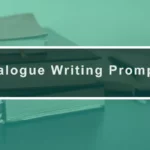
30 Engaging Dialogue Writing Prompts
In the realm of storytelling, dialogues breathe life into characters, giving them depth, personality, and …
Sign in to your account
Username or Email Address
Remember Me

17 Fun First Day Of School Writing Activities
The smell of freshly painted halls, the excited chatter of returning students bursting with two months’ worth of gossip to share—it must be the first day at school again.
Rusty pens and dusty pencils are hastily pulled from the bottom of school bags where, for many, they’ve lain all summer, ready for back to school.
You’ll need engaging writing activities to get those atrophied writing muscles back in shape. The standard ‘What I Did This Summer’ essay won’t cut it.
Luckily, we have 17 Great Back-to-School Writing Activities for you to help shake off the cobwebs and get your students’ writing skills back on par. Let’s get started.
Ice Breaker
Writing activities.
At the start of each school year, there’s likely to be a new face or two in the class, and while two months isn’t a long time in the grand scheme of things, our students can do a lot of growing and changing in that time.
Ice-breaker writing activities allow students to connect with others in the class. They give students some insight into the lives of their classmates.
Here are some fun ice-breaker writing activities to get the new school year off to a strong start writing-wise.
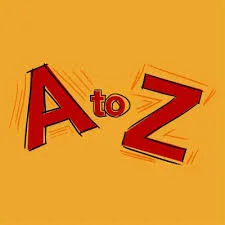
The A to Z of Me! Poem
Students write an acrostic poem about themselves in the A to Z of Me. The poem’s first line starts with the letter A, and each new line begins with the following letter of the alphabet, which should reveal something about the poet.
This may be too long for younger students – it’d be a 26-line poem after all. In this case, you can quickly adapt the activity to employ the letters of the student’s first name.
This activity aims for students to capture the essence of who they are in their poems. They can write a phrase or line based on their interests, appearance, things they have done, hobbies, desires, ideas, where they’re from, etc.
You can make this more challenging for older and stronger students by insisting they employ a rhyme scheme throughout their poems.
For example, they could write their poem in couplets (AA, BB, CC, etc.) or with an alternate line rhyming scheme (AB, AB, AB, etc).
When students have finished writing their acrostic poems about themselves, they can perform it to the whole class as a class poetry slam.
Guess Who? Writing Task
This fun activity challenges students to recall what they know about their classmates or, in the case of a newly formed group of students, to explore their initial impressions of each other.
In Guess Who?, the teacher divides the students into two groups. Each group writes down a unique fact about themselves on a piece of paper, folds it , and gives it to the teacher.
If everyone already knows each other very well, you might want to limit the facts to something they did over the summer that the others in the class are unaware of.
Students could write about a hobby or talent, a language they speak, a place they visited, or anything that makes them unique or special.
Students then take turns reading a fact written by someone from the other group, and they then guess who wrote it.
A point is awarded for each correct guess, the winning team being the team with the most points.

Interview A Classmate Writing Activity :
This activity allows students to get to know each other better while developing their interviewing, note-taking, and writing skills.
Begin this activity by asking the students to compile a list of questions that they would use to get to know someone they’d met for the first time.
The first questions the students generally tend to be surface-level small-talk-type questions such as:
- Where are you from?
- How many brothers and sisters do you have?
- What’s your favourite subject at school?
- What are your hobbies?
- What do you want to be when you grow up?
- What’s the best thing about you?
Write these on the whiteboard, of course. They’ll be helpful to as warm-up openers at the beginning of the interviews, but we want to encourage a deeper dive.
For the interviewer to better understand the interviewee, they’ll need to probe further.
Encourage students to come up with more challenging questions to ask in the interview and write these on the board. These questions should be geared toward gaining insight beyond the superficial.
Explain to the students that when they are the interviewee, if they’d prefer not to answer a specific question, they can just say “next” and the interviewer will move immediately onto the next question.
Some examples of deeper, more probing-type questions might include questions like:
- Can you tell me about an event or a story that significantly impacted your life?
- Who has had the most significant influence on who you are?
- What is the most challenging thing you’ve ever had to do?
- What is your best memory? Worst?
At the end of this brainstorming session, a considerable list of questions should be on the whiteboard.
Students are then partnered up. They will then take turns interviewing each other, with each interviewer taking comprehensive notes as they interview.
Students should not use voice recording equipment during this activity. This activity aims to improve note-taking abilities.
When the interviews are over, students write them up as best they can, using their notes and memories to recreate them.
For the more advanced students, this will involve recreating the interview’s dialogue and weaving a narrative around it to convey the interviewee’s character, expressions, and mannerisms.
First Day of School Persuasive Wish List Task
The start of a new school year is a time of hope and possibility captured in the form of a wish list.
But this isn’t an old wish list but a persuasive one.
The students will write a wish list of things they hope for from the new school year.
The twist is that they must make their case for why they should receive the concessions they seek.
Some items that might make the wish list could be the desire to see more time for their favourite activities, less homework, or creating a class council. It doesn’t matter what is on the list but that the student makes as strong a case as possible for them.
Students should be encouraged to use the full range of persuasive writing techniques available, from emotional language to social proof, from repetition to evidence and statistics.
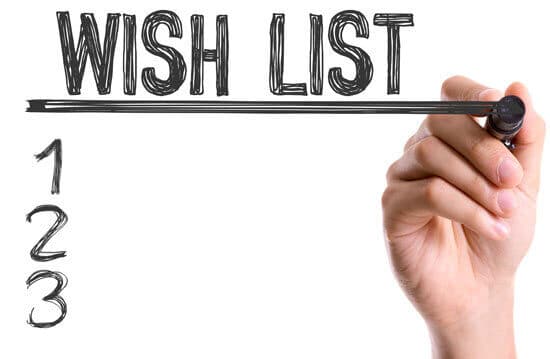
Collaborative Writing Activities
Collaborative writing activities offer students opportunities to work with a partner, a small group, or the whole class to produce a shared piece of writing.
As with the previous activities, these activities can break the ice. More than that, they help students establish a level of comfort working together to achieve a shared goal – a key dynamic to encourage at the start of any school year.

Snowball Story-Writing
In this simple but fun activity, each student starts by writing the beginning of a story. There should be an allotted amount of time to complete this, the length of which will depend on the age and abilities of the students.
When the allotted time is up, students should stop writing, roll their paper into a ball, and throw it towards the top of the classroom!
Students should then each retrieve one of the ‘snowballs’ from the front of the classroom and, when the timer is started, read the beginning of the story and then write the story middle until the time is up.
Again, the students throw their snowballs to the front of the classroom, before selecting a new snowball to write the ending.
When the stories are completed, they should be returned to the students who wrote the story beginning. This student should write a final draft of the story to ensure it reads well
Students can then share their stories by reading them out to the class.
Sometimes, students struggle to start their writing. To help them get going, it can be helpful to provide them with a sheet of paper with a writing prompt. This prompt can be a sentence or even a picture.
These prompts can be easily differentiated to suit the age and abilities of your students. For example, more prescriptive prompts are helpful for younger students, while more open-ended prompts will suit older and/or stronger students.
Tapestry Poems
Tapestry poems are a collaboration between two students. So, as a first step, you need to assign each student a partner to work with.
The next step requires you to assign a topic for each pair of students in the class. Each partner then independently writes a 9-line poem on the assigned topic.
When each student has finished their 9-line poem, they share them with their partner.
The task is for the students to work together now to produce an 18-line poem from the two 9-line poems they have created.
To do this, the students must collaborate to make the composite poem work. The idea here is to weave the different threads of the two topic interpretations into a single ‘tapestry’.
Students must include the nine lines of both poems, but they have room to edit for verb tense and make minor grammatical changes to make things work.
The partners must also compromise to agree on a single title for their shared piece.

The Peer Editing Exercise
This is a great way to introduce peer assessment into your classroom, especially with a group of students who are not familiar with the concept.
You will need to explain the editing and proofreading process to the students at the start. The specific criteria will, of course, depend on the age and abilities of your students.
To begin, organize the class into pairs of editing partners. Students should then swap their written work to be edited by their partners.
Any of the previous writing activities in this article would serve this purpose well.
Students can edit their partner’s work by annotating with a different colour pen, or, for more detailed commentary, they could use a separate sheet of paper.
Students then share their feedback.
This is an opportunity for students to see each other as resources to help them on their learning journey throughout the year.
It also helps students to develop resilience and an ability to absorb constructive criticism.
Students then rewrite their text in light of the feedback given.
Time for a plenary session should be made at the end to discuss their experiences of the process as a class.
The Summer Yearbook Writing Task
This writing project is based on the idea of school yearbooks.
School yearbooks are compilations of memories, photographs, and quotes. In this version, students compile a compendium based on their collective experiences during the school break.
The format can inspire many writing activities.
Students can gather quotes on the various events of vacation time together. These can be sourced from family, friends, classmates, etc.
They can also collect photographs and write suitable captions for inclusion in the yearbook. The book could include a page for the students’ autographs and a page for summer memories and hopes for the coming year.
Technology can be easily incorporated into this lesson by producing a digital version. Collaborative applications such as Google Drive are perfect for this type of work.

Year Long Inference Based Writing Activities
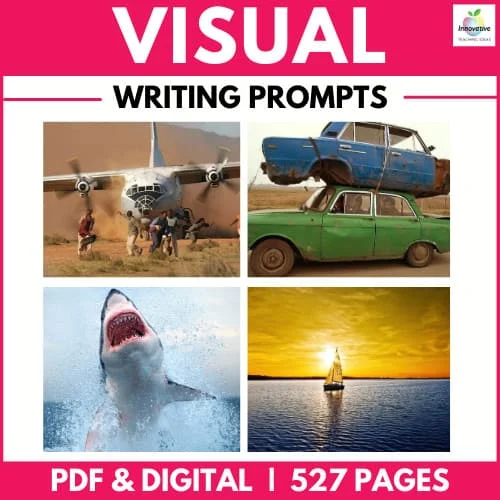
Tap into the power of imagery in your classroom to master INFERENCE as AUTHORS and CRITICAL THINKERS .
⭐⭐⭐⭐⭐ (26 Reviews)
This YEAR-LONG 500+ PAGE unit is packed with robust opportunities for your students to develop the critical skill of inference through fun imagery, powerful thinking tools, and graphic organizers.
Memory Writing Activities
While we want to avoid the cliched ‘ What I Did This Summer ’ essay, it doesn’t mean that memories of the long holidays can’t serve as an ‘ in’ to some worthwhile writing activities.
In the following writing activities, students will be asked to access their memories of summer to serve as a jumping-off point. Let’s get started!

Paint a Picture With Words
Essentially, this writing activity challenges students to write by employing their senses to evoke a memory.
First, ask the students to choose from a memory of a place they visited during the summer vacation. It doesn’t matter whether it’s a beach trip or a visit to a shopping mall; they’ll both serve equally well for this activity.
Students must then endeavour to recreate the scene as they recall it through careful selection of vocabulary and description.
The main focus of this type of writing will be the use of sensory language. Students should meditate on what they saw, heard, smelled, tasted, and felt while in their chosen place.
Students should work to paint a vivid, multi-dimensional picture in the reader’s minds-eye. For this reason, they should choose a static memory, such as a scene they recall. This activity has more in common with landscape painting than with film-making. A plot is not required.
This activity allows students to hone their descriptive writing skills, which will help them improve their writing in many genres.
Haiku Writing Activity
As with the last activity, this type of poetry is typically focused on evoking a scene. In the case of the haiku, this is usually a natural scene.
Before putting pen to paper, be sure students are suitably familiar with the features of the haiku:
- It consists of 3 lines
- It contains 17 syllables
- The 1st and 3rd lines have 5 syllables and the 2nd line has 7 syllables
- It does not need to rhyme
- It’s usually about nature or a natural phenomenon
- Often has two contrasting or juxtaposed subjects woven into it.
This activity is best introduced by reading and examining a couple of well-written haikus, such as those by Basho in translation, to ensure student familiarity with the form.
This is a very meditative writing form. It is essential to set a suitable mood and atmosphere in the classroom to encourage the necessary concentration and reflection the writing process will require. Playing gentle instrumental music is one way to help achieve this ambience.

Fun Back To School Writing Activities
While the first of our Back to School Writing Activities focuses clearly on breaking the ice and drawing on memories, the primary focus of the following writing activities is on having fun.
These activities will also offer students opportunities to develop some technical aspects of their writing skills; the main emphasis here is on students seeing writing as a fun, creative activity where they have the space and time for self-expression.
Don’t forget to read our complete guide to Fun Writing activities here.

Creative Excuses Writing Task
To start this activity, students must devise a list of 10 chores or tasks they absolutely hate doing.
Next, students should choose four from this list of their most detested tasks and write a letter explaining why they cannot complete them.
Encourage students to get creative with their excuses. The crazier and more imaginative the excuses are, the better. This activity is an opportunity for students to let their imaginations loose.
‘What If?’ Writing Prompts
Writing prompts are an excellent way for students to break through writer’s block. In this activity, students generate their own writing prompts by creating ‘ what if? ’ scenarios for other students in the class to use as writing prompts.
Many of the best and most creative stories start with an inquiry into what would happen if x happened. These scenarios can be silly, serious, fantastical, or humorous if they provide a jumping-off point for the student writer.
When students have completed their prompts, the teacher should gather them to distribute randomly among the class.
Students can share their work with the class When they have finished writing their responses to their assigned prompts. This will be especially interesting for the writer of the original prompt.

The Book Of Summer
This writing activity is an upgrade from the “My Summer Vacation” type essays.
In this activity, each student will compile their Book of Summer, describing and depicting their holidays using as many different writing genres as possible.
For example, the student might include the following in their Book of Summer:
- A non-chronological report on a day trip
- A comic strip based on a family celebration
- A review of a movie they saw or book they read
- A fictionalized account of their summer
- A recipe of a meal they made
- A playscript for a sleepover they went on
- A haiku on the end of summer
The scope for creative interpretations here is almost endless.
For younger students , it may be best to be more prescriptive about the various genres to include and the titles for each piece.
But for students with the ability, the open-endedness of this task allows their creativity to run loose while affording you a valuable opportunity to see just what they are capable of.
Be sure to read our complete collection of back-to-school writing activities.
Fictional Interviews Writing Task
This activity involves a little bit of writing and a lot of role-playing.
In this activity, students should be paired up with a partner. Each partner chooses a fictional character they will role-play. The character can be from any fiction, for example, movies, comic books, or literature.
Partners must prepare and write up a series of interview questions for their partner’s fictional character.
Partners take turns interviewing each other while the interviewee is in character.
This is a great way to bring a bit of drama into the classroom, but if you want to emphasize the writing aspect of the activity, you can set the students up for the interview in the style of a magazine feature article. This will require the student to weave some narrative writing around the back and forth of the questions and answers of the interview.

Write A Story From A Different Point Of View
Narrative writing requires competency in a broad range of complex skills . We can roughly divide those skills into structural ones (such as text organization) and language-related skills (such as sentence construction and creativity).
Getting your students to write a story is a great way to assess their abilities in these areas.
In this activity, however, you provide most of the structure for the student, giving them the space to exercise their imagination and a chance to focus on their grammatical control – among other things.
In this exercise, ask your students to select a favourite fairy tale or other traditional story they know well. The student’s task is to rewrite their favourite fairy tale from the point of view of another important character in the story.
For example, they might want to retell the Jack and the Beanstalk story from the point of view of the Giant or Jack’s mother.
Retelling The Ugly Duckling , the student might want to write from Mother Duck’s perspective to explore her feelings about the runt of her litter suddenly transforming into a beautiful (if alien!) swan
Summer Headlines Writing Activity
Headlines are fun to write .
They should be short and pithy, seizing the reader’s attention by telling them just enough about the story to pique their interest but still leave them wanting to read more.
There are several things that students can do to ensure their headlines have the desired effect, including:
- Choose powerful words designed to make an impact
- Use alliteration to create catchy, snappy headlines
- Employ humour to entertain and intrigue the reader
- Create suspense by posing the headline as a question
For this activity, students should list the main events of their summer break and create a headline for each event.
In this way, the students will have produced an account of their summer written entirely in headlines.
As an extension to this exercise, when they’ve finished producing their headlines, have them present them to the class or in smaller groups.
The best headline is selected from each list, which the student has to turn into a complete newspaper-style article on that event.

Rap and Verse Writing Task
Few genres of writing can be as divisive.
Some are dismayed by the mere mention of the word ‘poetry’ – The “ Why can’t poets just say what they mean? ” camp.
Then, some can barely write a shopping list without a bit of unnecessary versifying.
Love it or loathe it, poetry is on the curriculum and our students need to get to grips with it.
For this activity, students write a series of poems inspired by the events of their summer holidays. Essentially, they are writing a poetic account of their vacation.
To challenge the students, they must use a different type of poetry for each event they wish to retell.
For example, they might write a series of haikus on the weather during the summer break.
Perhaps they’ll produce a calligram or shape poem describing the treehouse they made.
Maybe they’ll write an elegy to a pet that died or a limerick on that disastrous camping trip.
They might like to use the headlines from the previous activity A Summer in Headlines as starting points for their poems.
By the end of this activity, your students will have a collection of self-authored poetry they can share with the class in the form of a poetry slam.
You may wish to provide your students with checklists of the various features of the different types of poetry to help them during this activity.
So, there we have seventeen engaging activities to kick start the writing process at the start of the school year.
There is quite a variety from here, with some activities honing technical aspects of the writing process while others are more centred on the fun of creativity.
Remember, at the start of the school year, what the students write isn’t so important, but what they write!
With the selection of activities above, you’re sure to find one to suit even the most pen-shy students!
Daily Quick Writes For All Text Types

Our FUN DAILY QUICK WRITE TASKS will teach your students the fundamentals of CREATIVE WRITING across all text types. Packed with 52 ENGAGING ACTIVITIES
OTHER GREAT WRITING ACTIVITIES TO TRY

7 Evergreen Writing Activities for Elementary Students

10 fun writing activities for the reluctant writer

13 Fun Reading Activities for Any Book
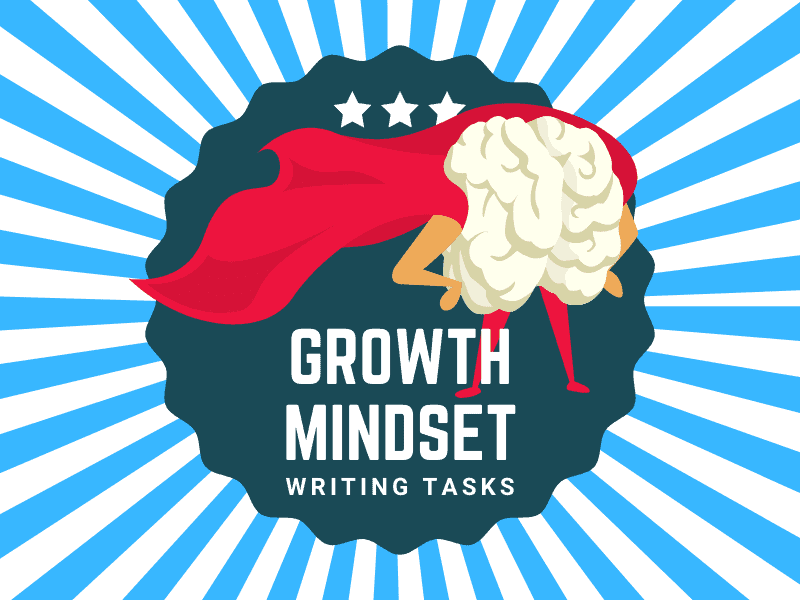
5 Fun Growth Mindset Writing Activities Students and Teachers Love

6 YouTube Writing Activities for Students and Teachers
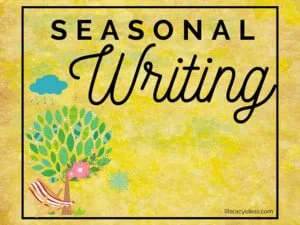
5 Fun Seasonal Writing Activities Students and Teachers Love
- CORE CURRICULUM
- LITERACY > CORE CURRICULUM > Into Literature, 6-12" data-element-type="header nav submenu" title="Into Literature, 6-12" aria-label="Into Literature, 6-12"> Into Literature, 6-12
- LITERACY > CORE CURRICULUM > Into Reading, K-6" data-element-type="header nav submenu" title="Into Reading, K-6" aria-label="Into Reading, K-6"> Into Reading, K-6
- INTERVENTION
- LITERACY > INTERVENTION > English 3D, 4-12" data-element-type="header nav submenu" title="English 3D, 4-12" aria-label="English 3D, 4-12"> English 3D, 4-12
- LITERACY > INTERVENTION > Read 180, 3-12" data-element-type="header nav submenu" title="Read 180, 3-12" aria-label="Read 180, 3-12"> Read 180, 3-12
- LITERACY > READERS > Hero Academy Leveled Libraries, PreK-4" data-element-type="header nav submenu" title="Hero Academy Leveled Libraries, PreK-4" aria-label="Hero Academy Leveled Libraries, PreK-4"> Hero Academy Leveled Libraries, PreK-4
- LITERACY > READERS > HMH Reads Digital Library, K-5" data-element-type="header nav submenu" title="HMH Reads Digital Library, K-5" aria-label="HMH Reads Digital Library, K-5"> HMH Reads Digital Library, K-5
- LITERACY > READERS > inFact Leveled Libraries, K-5" data-element-type="header nav submenu" title="inFact Leveled Libraries, K-5" aria-label="inFact Leveled Libraries, K-5"> inFact Leveled Libraries, K-5
- LITERACY > READERS > Rigby PM, K-5" data-element-type="header nav submenu" title="Rigby PM, K-5" aria-label="Rigby PM, K-5"> Rigby PM, K-5
- LITERACY > READERS > Science & Engineering Leveled Readers, K-5" data-element-type="header nav submenu" title="Science & Engineering Leveled Readers, K-5" aria-label="Science & Engineering Leveled Readers, K-5"> Science & Engineering Leveled Readers, K-5
- SUPPLEMENTAL
- LITERACY > SUPPLEMENTAL > A Chance in the World SEL, 8-12" data-element-type="header nav submenu" title="A Chance in the World SEL, 8-12" aria-label="A Chance in the World SEL, 8-12"> A Chance in the World SEL, 8-12
- LITERACY > SUPPLEMENTAL > Amira Learning, K-6" data-element-type="header nav submenu" title="Amira Learning, K-6" aria-label="Amira Learning, K-6"> Amira Learning, K-6
- LITERACY > SUPPLEMENTAL > Classcraft, K-8" data-element-type="header nav submenu" title="Classcraft, K-8" aria-label="Classcraft, K-8"> Classcraft, K-8
- LITERACY > SUPPLEMENTAL > JillE Literacy, K-3" data-element-type="header nav submenu" title="JillE Literacy, K-3" aria-label="JillE Literacy, K-3"> JillE Literacy, K-3
- LITERACY > SUPPLEMENTAL > Waggle, K-8" data-element-type="header nav submenu" title="Waggle, K-8" aria-label="Waggle, K-8"> Waggle, K-8
- LITERACY > SUPPLEMENTAL > Writable, 3-12" data-element-type="header nav submenu" title="Writable, 3-12" aria-label="Writable, 3-12"> Writable, 3-12
- LITERACY > SUPPLEMENTAL > ASSESSMENT" data-element-type="header nav submenu" title="ASSESSMENT" aria-label="ASSESSMENT"> ASSESSMENT
- CORE CURRICULUM
- MATH > CORE CURRICULUM > Arriba las Matematicas, K-8" data-element-type="header nav submenu" title="Arriba las Matematicas, K-8" aria-label="Arriba las Matematicas, K-8"> Arriba las Matematicas, K-8
- MATH > CORE CURRICULUM > Go Math!, K-6" data-element-type="header nav submenu" title="Go Math!, K-6" aria-label="Go Math!, K-6"> Go Math!, K-6
- MATH > CORE CURRICULUM > Into Algebra 1, Geometry, Algebra 2, 8-12" data-element-type="header nav submenu" title="Into Algebra 1, Geometry, Algebra 2, 8-12" aria-label="Into Algebra 1, Geometry, Algebra 2, 8-12"> Into Algebra 1, Geometry, Algebra 2, 8-12
- MATH > CORE CURRICULUM > Into Math, K-8" data-element-type="header nav submenu" title="Into Math, K-8" aria-label="Into Math, K-8"> Into Math, K-8
- MATH > CORE CURRICULUM > Math Expressions, PreK-6" data-element-type="header nav submenu" title="Math Expressions, PreK-6" aria-label="Math Expressions, PreK-6"> Math Expressions, PreK-6
- MATH > CORE CURRICULUM > Math in Focus, K-8" data-element-type="header nav submenu" title="Math in Focus, K-8" aria-label="Math in Focus, K-8"> Math in Focus, K-8
- SUPPLEMENTAL
- MATH > SUPPLEMENTAL > Classcraft, K-8" data-element-type="header nav submenu" title="Classcraft, K-8" aria-label="Classcraft, K-8"> Classcraft, K-8
- MATH > SUPPLEMENTAL > Waggle, K-8" data-element-type="header nav submenu" title="Waggle, K-8" aria-label="Waggle, K-8"> Waggle, K-8
- MATH > INTERVENTION > Math 180, 5-12" data-element-type="header nav submenu" title="Math 180, 5-12" aria-label="Math 180, 5-12"> Math 180, 5-12
- SCIENCE > CORE CURRICULUM > Into Science, K-5" data-element-type="header nav submenu" title="Into Science, K-5" aria-label="Into Science, K-5"> Into Science, K-5
- SCIENCE > CORE CURRICULUM > Into Science, 6-8" data-element-type="header nav submenu" title="Into Science, 6-8" aria-label="Into Science, 6-8"> Into Science, 6-8
- SCIENCE > CORE CURRICULUM > Science Dimensions, K-12" data-element-type="header nav submenu" title="Science Dimensions, K-12" aria-label="Science Dimensions, K-12"> Science Dimensions, K-12
- SCIENCE > READERS > inFact Leveled Readers, K-5" data-element-type="header nav submenu" title="inFact Leveled Readers, K-5" aria-label="inFact Leveled Readers, K-5"> inFact Leveled Readers, K-5
- SCIENCE > READERS > Science & Engineering Leveled Readers, K-5" data-element-type="header nav submenu" title="Science & Engineering Leveled Readers, K-5" aria-label="Science & Engineering Leveled Readers, K-5"> Science & Engineering Leveled Readers, K-5
- SCIENCE > READERS > ScienceSaurus, K-8" data-element-type="header nav submenu" title="ScienceSaurus, K-8" aria-label="ScienceSaurus, K-8"> ScienceSaurus, K-8
- SOCIAL STUDIES > CORE CURRICULUM > HMH Social Studies, 6-12" data-element-type="header nav submenu" title="HMH Social Studies, 6-12" aria-label="HMH Social Studies, 6-12"> HMH Social Studies, 6-12
- SOCIAL STUDIES > SUPPLEMENTAL > Writable" data-element-type="header nav submenu" title="Writable" aria-label="Writable"> Writable
- For Teachers
- PROFESSIONAL DEVELOPMENT > For Teachers > Coachly" data-element-type="header nav submenu" title="Coachly" aria-label="Coachly"> Coachly
- PROFESSIONAL DEVELOPMENT > For Teachers > Teacher's Corner" data-element-type="header nav submenu" title="Teacher's Corner" aria-label="Teacher's Corner"> Teacher's Corner
- PROFESSIONAL DEVELOPMENT > For Teachers > Live Online Courses" data-element-type="header nav submenu" title="Live Online Courses" aria-label="Live Online Courses"> Live Online Courses
- For Leaders
- PROFESSIONAL DEVELOPMENT > For Leaders > The Center for Model Schools (formerly ICLE)" data-element-type="header nav submenu" title="The Center for Model Schools (formerly ICLE)" aria-label="The Center for Model Schools (formerly ICLE)"> The Center for Model Schools (formerly ICLE)
- MORE > undefined > Assessment" data-element-type="header nav submenu" title="Assessment" aria-label="Assessment"> Assessment
- MORE > undefined > Early Learning" data-element-type="header nav submenu" title="Early Learning" aria-label="Early Learning"> Early Learning
- MORE > undefined > English Language Development" data-element-type="header nav submenu" title="English Language Development" aria-label="English Language Development"> English Language Development
- MORE > undefined > Homeschool" data-element-type="header nav submenu" title="Homeschool" aria-label="Homeschool"> Homeschool
- MORE > undefined > Intervention" data-element-type="header nav submenu" title="Intervention" aria-label="Intervention"> Intervention
- MORE > undefined > Literacy" data-element-type="header nav submenu" title="Literacy" aria-label="Literacy"> Literacy
- MORE > undefined > Mathematics" data-element-type="header nav submenu" title="Mathematics" aria-label="Mathematics"> Mathematics
- MORE > undefined > Professional Development" data-element-type="header nav submenu" title="Professional Development" aria-label="Professional Development"> Professional Development
- MORE > undefined > Science" data-element-type="header nav submenu" title="Science" aria-label="Science"> Science
- MORE > undefined > undefined" data-element-type="header nav submenu">
- MORE > undefined > Social and Emotional Learning" data-element-type="header nav submenu" title="Social and Emotional Learning" aria-label="Social and Emotional Learning"> Social and Emotional Learning
- MORE > undefined > Social Studies" data-element-type="header nav submenu" title="Social Studies" aria-label="Social Studies"> Social Studies
- MORE > undefined > Special Education" data-element-type="header nav submenu" title="Special Education" aria-label="Special Education"> Special Education
- MORE > undefined > Summer School" data-element-type="header nav submenu" title="Summer School" aria-label="Summer School"> Summer School
- BROWSE RESOURCES
- BROWSE RESOURCES > Classroom Activities" data-element-type="header nav submenu" title="Classroom Activities" aria-label="Classroom Activities"> Classroom Activities
- BROWSE RESOURCES > Customer Success Stories" data-element-type="header nav submenu" title="Customer Success Stories" aria-label="Customer Success Stories"> Customer Success Stories
- BROWSE RESOURCES > Digital Samples" data-element-type="header nav submenu" title="Digital Samples" aria-label="Digital Samples"> Digital Samples
- BROWSE RESOURCES > Events" data-element-type="header nav submenu" title="Events" aria-label="Events"> Events
- BROWSE RESOURCES > Grants & Funding" data-element-type="header nav submenu" title="Grants & Funding" aria-label="Grants & Funding"> Grants & Funding
- BROWSE RESOURCES > International" data-element-type="header nav submenu" title="International" aria-label="International"> International
- BROWSE RESOURCES > Research Library" data-element-type="header nav submenu" title="Research Library" aria-label="Research Library"> Research Library
- BROWSE RESOURCES > Shaped - HMH Blog" data-element-type="header nav submenu" title="Shaped - HMH Blog" aria-label="Shaped - HMH Blog"> Shaped - HMH Blog
- BROWSE RESOURCES > Webinars" data-element-type="header nav submenu" title="Webinars" aria-label="Webinars"> Webinars
- CUSTOMER SUPPORT
- CUSTOMER SUPPORT > Contact Sales" data-element-type="header nav submenu" title="Contact Sales" aria-label="Contact Sales"> Contact Sales
- CUSTOMER SUPPORT > Customer Service & Technical Support Portal" data-element-type="header nav submenu" title="Customer Service & Technical Support Portal" aria-label="Customer Service & Technical Support Portal"> Customer Service & Technical Support Portal
- CUSTOMER SUPPORT > Platform Login" data-element-type="header nav submenu" title="Platform Login" aria-label="Platform Login"> Platform Login
- Learn about us
- Learn about us > About" data-element-type="header nav submenu" title="About" aria-label="About"> About
- Learn about us > Diversity, Equity, and Inclusion" data-element-type="header nav submenu" title="Diversity, Equity, and Inclusion" aria-label="Diversity, Equity, and Inclusion"> Diversity, Equity, and Inclusion
- Learn about us > Environmental, Social, and Governance" data-element-type="header nav submenu" title="Environmental, Social, and Governance" aria-label="Environmental, Social, and Governance"> Environmental, Social, and Governance
- Learn about us > News Announcements" data-element-type="header nav submenu" title="News Announcements" aria-label="News Announcements"> News Announcements
- Learn about us > Our Legacy" data-element-type="header nav submenu" title="Our Legacy" aria-label="Our Legacy"> Our Legacy
- Learn about us > Social Responsibility" data-element-type="header nav submenu" title="Social Responsibility" aria-label="Social Responsibility"> Social Responsibility
- Learn about us > Supplier Diversity" data-element-type="header nav submenu" title="Supplier Diversity" aria-label="Supplier Diversity"> Supplier Diversity
- Join Us > Careers" data-element-type="header nav submenu" title="Careers" aria-label="Careers"> Careers
- Join Us > Educator Input Panel" data-element-type="header nav submenu" title="Educator Input Panel" aria-label="Educator Input Panel"> Educator Input Panel
- Join Us > Suppliers and Vendors" data-element-type="header nav submenu" title="Suppliers and Vendors" aria-label="Suppliers and Vendors"> Suppliers and Vendors
- Divisions > Center for Model Schools (formerly ICLE)" data-element-type="header nav submenu" title="Center for Model Schools (formerly ICLE)" aria-label="Center for Model Schools (formerly ICLE)"> Center for Model Schools (formerly ICLE)
- Divisions > Heinemann" data-element-type="header nav submenu" title="Heinemann" aria-label="Heinemann"> Heinemann
- Divisions > NWEA" data-element-type="header nav submenu" title="NWEA" aria-label="NWEA"> NWEA
- Platform Login
SOCIAL STUDIES
PROFESSIONAL DEVELOPMENT
29 Back-to-School Writing Prompts for Middle and High School

The first day of school is approaching, and as a teacher, your schedule is likely already filling up with organizational and instructional prep work. However, despite all of your efforts, you may find that some students may emerge slowly from their summer hazes.
Before your middle school or high school students start their assigned reading, get them engaged with these back-to-school writing prompts. Fill up some class time with a few warm-up writing prompts below, or send students home with a larger assignment to get them back into the swing of things!
First Day of School Writing Prompts: Middle School Students
Classroom Prompt Assignments
- Stream of consciousness is when a character lets their thoughts continuously flow. Write a stream of consciousness story of your own and see where your thoughts take you.
- For the new school year, what new skill would you choose to learn if you had the time, money, and ability? Why?
- Write a critique of a book, movie, or show you recently read or watched. What were its strong points? What were its weak ones?
- Describe the reigning emotions you felt this summer. Why did you feel that way, and how do you think these emotions might change as the school year progresses?
- Choose a place you traveled to this summer, either locally or far away, and write a blog post about that location. Should other people visit as well? It could be a restaurant, a town, a shop, or a favorite spot to hang out.
- If there is a club, sport, class, or event you are excited about this year, write what you already know about it. Follow up with some expectations that you have for the experience and yourself.
- A flashbulb memory is a very detailed memory that you have from when you were young. Do you have any memories like that, and if so, what are they about? Are there any events that have happened recently that you think you will remember for a long time?
- Do you have any traditions? If not, which one would you want to start this year?
- Describe the most memorable school project that you’ve ever done. Would you like to do a similar project this year, and if so, how can it be adapted to what you’re learning now?
- If you could create a themed book display for your school library, what would it be? Which titles would it include, and why?
Take-Home Writing Assignments
- Write a letter to your younger self, and then another to your older self.
- One important rule of creative writing is to “Show Don’t Tell.” Write a 1,500-word short story in your favorite genre, following this rule.
- Write a local wildlife guide to your backyard, neighborhood, local park, or even the school itself. What flora and fauna exist there?
- Write a 1,000-word essay about an aspect of your summer that focuses on the five basic senses—Sight, Hearing, Smell, Taste, and Touch.

First Day of School Writing Prompts: High School Students
- Set three resolutions for yourself to accomplish this year and describe why those are the ones you chose.
- Write a list of How-To instructions for something that you know how to do. It could be making a meal, cleaning something, playing a game, babysitting, drawing a picture, etc.
- Create a dream college for you to attend once you graduate. Which academic programs does it offer? What sports, art classes, and clubs are offered? Where is it located?
- Write a short story using only dialogue. Work on creating different voices for each character. If it helps, take notes on each character before the dialogue starts. Does one character use slang? Is the other excitable? Is one character older than the other?
- Write a song on a subject that isn’t usually heard in other songs.
- Create a new class for your school to offer. Why do you think that class is necessary? What are the learning goals for that class, and what are the assignments?
- Which app do you spend the most time on? What are the positive aspects of using the app? What are the negatives?
- Is there a cause that you want to be a part of? What is it, and why is it important to you?
- Create a new club for your community or school. What is the club about? What are your goals, and who do you hope will join?
- Describe three things that you are looking forward to this year.
- What is your ultimate dream job? Research the industry, company, or role you’re interested in and report on what it is and how to get there. Conclude with your expectations before and after your research. Is the job what you thought it was?
- Choose a position with the local government to run for and outline a platform to run on. Then, write a speech to voters about your platform. Make sure to research your current representatives to learn what their platforms are.
- What is going on in the town or city that you live in? Research local events, places, volunteer opportunities, parks, clubs, etc. Visit a new place or attend a new event, then write a review of your experiences using descriptive language. Would you go back again? Why or why not?
- An executive summary is an intro to a business plan that is designed to grab the reader’s attention by summarizing what the new business will accomplish. Write an executive summary between 500 and 1,000 words for a product, venture, or business that you wish existed.
- Research a historical figure that looks a little like you do (bonus points if you’ve never heard of them before now). What did they accomplish?
No matter how much or how little your students read this summer, get their creativity flowing with these thought-provoking journal prompts to kick off the year. By focusing on descriptive language, persuasive arguments, and ideas for the future, your middle school or high school class will find their writer's stride in no time.
Try Writable to support your ELA curriculum, district benchmarks, and state standards with more than 600 fully customizable writing assignments and rubrics for students in Grades 3–12 .
Try out a free trial of Writable today by following these steps:
- Go to hmh.writable.com
- Click "Log in or Create Account"
- Choose "I'm a teacher"
- Sign in with Google or Microsoft account
- Select the grade level you teach
- Activities & Lessons
- Grades 9-12
Related Reading

Podcast: Building Vocabulary to Increase Reading Comprehension with Abbey Behnke in WI on Teachers in America
Jennifer Corujo Shaped Editor
May 22, 2024

Scaffolding Writing Instruction
Alicia Ivory Shaped Editor
May 20, 2024

10 Math Intervention Strategies for Struggling Students
Shaped Executive Editor
May 7, 2024
8 First Day of High School Activities to Get to Know Your Students
- Lesson Plans
- Grading Students for Assessment
- Becoming A Teacher
- Assessments & Tests
- Elementary Education
- Special Education
- Homeschooling
:max_bytes(150000):strip_icc():format(webp)/squareheadshot-5b6da9aec9e77c0050a6e8a5.jpg)
The first day of high school is full of excitement and nerves for students and teachers alike. You can put your students at ease right away by enthusiastically welcoming them to your class and greeting them at the door with a smile, an introduction, and a handshake.
The first day will inevitably involve some logistics, like going over the class rules and reviewing the course syllabi. However, you can make your students' introduction to your classroom stress-free and positive by adding these fun first day of high school activities.
Would You Rather?
Help the teens in your class relax with a fun round of "Would You Rather," the game in which you pit two choices against each other. Sometimes the choices are serious; other times they’re silly. Occasionally, neither is a good option, forcing students to choose the lesser of two evils.
Get started with these these Would You Rather prompts. Would you rather...
- Live in the mountains or on the beach?
- Be a famous author or a famous musician?
- Have the ability to read minds or be invisible?
- Spend the day at an amusement park or the mall?
- Have a private jet or a fancy sports car?
- Live somewhere that is always warm and sunny, or somewhere that is always cold and snowy?
After you ask each question, instruct students to move to one side of the room if they’d choose the first option and the other if they’d prefer the second.
If you’d rather keep everyone in their seats, provide students with different color choice markers (e.g. colored paper plates, paint stir sticks). Students hold up one color for the first choice and the other color for the second.
Two Truths and a Lie
Get to know your students and help them get to know each other with the classic icebreaker game Two Truths and a Lie. Tell the students to share two true facts and one made-up fact about themselves. After a student shares their facts, the other students should guess which statement is a lie.
For example, a student might say, “I moved here from California . My birthday is in October. And, I have three brothers.” The other students then guess which of the three statements is untrue until the first student reveals that they are an only child.
You can start the game by sharing two truths and a lie about yourself, then go around the room until each student gets a turn.
Letter to Yourself
Begin the school year with this introspective activity. Invite the students to write a letter to their future selves. Provide a list of questions, writing prompts , or sentence starters and instruct students to answer the questions in complete sentences. Try some of the following:
- I am wearing…
- My best friend is…
- What I’m looking forward to most this year is…
- What is your favorite subject?
- What are your favorite songs, TV shows, books, games, or music artists?
- What are your hobbies?
- What is your favorite way to spend your free time?
Provide envelopes so that students can seal their letters once they’re complete. Then, the students should turn in their sealed letters to you for safe-keeping. Return the messages to the students on their last day of school .
Tell Me About Yourself
Get to know your students with an engaging questionnaire. Write five to ten questions—some lighthearted, a few thoughtful—on the board or provide a printed handout. Ask questions such as:
- What is one of your favorite memories?
- Are you an introvert or an extrovert ?
- What qualities does a great teacher have?
- How do you learn best (examples: quiet environment, hands-on, listening, reading)?
- If you could only eat one food for the rest of your life, what would it be?
Students should turn in their finished questionnaires to you. Use this activity as an opportunity to gain insight into their personalities.
Pop Culture Quiz
Take a break from the first-day-of-school stress with a pop quiz — a pop culture quiz.
In advance, create a list of 10-15 questions about current pop culture, from music to movies. Then, to begin the game, divide the class into multiple teams. Distribute paper and pens/markers or personal whiteboards to each team.
Stand at the front of the room and ask one question at a time. Give the teams time (30-60 seconds) to confer quietly about their answers. Each team should write down their final answer on a piece of paper. Once the time is up, ask each team to hold up their answer. Each team that answers correctly earns a point. Record the score on the board. Whichever team earns the most points wins.
Anonymous Responses
Create a sense of community and connection in your classroom through this activity. In advance, prepare one or two questions to ask the students. Here are some examples:
- What makes you most nervous about the new school year?
- What is one thing you wish everyone at school knew about you?
- What is your biggest goal this school year?
Write your question(s) on the board, pass out an index card to each student. Explain that they should write down their answers without including their name, and assure them that their responses are completely anonymous (but that they will be shared with the group). Give the class 5 minutes to complete the activity. When time is up, instruct students to fold their cards once and place them in a basket or bin at the front of the room.
Once everyone has turned in their index cards, read the responses out loud. Many students may be surprised to find out how similar they are to their classmates. To extend the activity, moderate a brief discussion about the students' reactions to hearing their classmates' responses.
Teacher Multiple Choice Quiz
Give your students a chance to get to know you through a silly multiple choice quiz. To create the quiz, come up with a list of fun or surprising facts about yourself. Then, turn them into multiple choice questions. Be sure to include some funny wrong answers.
After the students have finished the quiz, go over the correct answers and have the students "grade" their own quizzes. This activity often generates fun, engaging discussions, as many students are curious to hear the backstories behind some of the facts you included on the quiz.
Classmate Interviews
Divide the students into pairs and pass out a list of interview question prompts. Tell the students to be on the lookout for things they have in common. Then, give the students 10 minutes to interview their partners. When time is up, each student should introduce their partner to the class using the information they learned during the meeting. Each presentation should include a fun fact and a newly-discovered commonality.
This activity is an excellent way for students to get to know each other. In addition, many students find it less intimidating to speak to the class about someone else rather than themselves.
- Ice Breakers for the First Day of Elementary School
- Last Day of School Activities
- Adult Ice Breaker Games for Classrooms, Meetings, and Conferences
- Fun Classroom Introductions for the First Day of School
- Make Test Prep Fun Through Play
- 6 Ways Elementary School Teachers Can Welcome Students Back to School
- How to Set up Your Classroom for the First Day of School
- 5 Successful Review Activities for Elementary Students
- Back-to-School Student Questionnaire
- Fun Field Day Activities for Elementary Students
- What Grad Students Can Expect on Their First Day
- 7 Fun Ideas for Morning Meeting Greetings
- Behavior Incentives in the Classroom
- 10 Ways Teachers Can Communicate Expectations to Students
- Would You Rather
- It's Your First Day Teaching French Class: Now What?

20 Writing Prompts For High School Seniors [PDF Included]
Hello, high school seniors! Are you struggling to come up with ideas for your next writing assignment? Do you find yourself staring at a blank page, feeling uninspired and unmotivated?
Well, fear not! We have compiled a list of writing prompts that will help kickstart your creativity and get those words flowing. Today’s high school students have to engage in a lot of writing, particularly in their academic settings. And the only way to get better at it is through continuous practice.
Writing skills are bound to improve with a daily writing habit. Whether you’re a budding novelist, a poet, or a nonfiction writer, these prompts will spark your imagination and give you the inspiration you need to write your next masterpiece. So grab your favorite pen or laptop and let’s get started!
Writing prompts for high school seniors
- Write a letter to yourself in middle school. What would you want them to know?
- Write an essay about what role technology plays in your life
- Write a story about how peer pressure affects all of the characters in the story
- Select your favorite song lyric and turn it into a poem
- Write an ode to your favorite subject in high school
- What is the state of the globe now that global warming has reached its worst point?
- Write a poem including something from each year of high school
- What is trending on social media currently and what are your views regarding it?
- What will you miss the most about high school?
- Write an ode to your high school friends.
- Reflect on a defining moment in your high school career and how it shaped you as a person.
- Write about a challenge you faced during high school and how you overcame it.
- Imagine that you are giving a graduation speech to your peers. What advice would you give them as they embark on the next phase of their lives?
- Write about a person who has had a significant impact on your life and why they are important to you.
- Reflect on a time when you had to make a difficult decision and how you came to that decision.
- Write about a skill or talent that you developed during high school and how it has helped you grow as a person.
- Imagine that you have the opportunity to travel back in time and give advice to your freshman self. What would you say?
- Write about a book, movie, or song that has had a profound impact on your life and why it is meaningful to you.
- Reflect on a time when you had to step out of your comfort zone and try something new. What did you learn from the experience?
- Imagine that you are interviewing for your dream job. What skills and experiences have you gained in high school that make you a strong candidate?

Transforming your writing from meh to marvelous: Tips and strategies for high schoolers
Writing can be a daunting task, like a high-stakes game of Jenga where one wrong move could send everything crashing down. But fear not, my fellow word-wielders! With a few tips and strategies, you can stack your ideas into a towering masterpiece without breaking a sweat.
From brainstorming to editing, it’s all about finding the right balance and not being afraid to take risks. So grab your pen (or keyboard) and let’s dive into the wild world of writing!
- Start with a plan: Before you begin writing, take a few minutes to brainstorm and outline your ideas. This will help you organize your thoughts and make sure your writing stays on track.
- Be concise: High schoolers often have a tendency to be wordy in their writing. Try to be as clear and concise as possible, and avoid using unnecessary words or phrases.
- Use active voice: Active voice makes your writing more engaging and direct. Instead of saying “the ball was thrown by John,” say “John threw the ball.”
- Use strong verbs and adjectives: Using strong verbs and adjectives can help make your writing more vivid and engaging. Instead of saying “the car was fast,” say “the car zoomed down the road.”
- Edit your work: Take the time to review your writing and make sure it is free from errors. Read your work aloud to catch any awkward phrasing or grammar mistakes.
- Get feedback: Share your writing with others and ask for feedback. This can help you identify areas where you can improve and make your writing stronger.
- Read widely: Reading widely can help you develop your writing skills by exposing you to different writing styles and techniques. Make a habit of reading regularly, both for pleasure and for academic purposes.
- Practice, practice, practice: Writing is a skill that takes time and practice to develop. Set aside time each day to write, even if it’s just for a few minutes. The more you write, the better you will become.
Furthermore, high schoolers can also be indulged in some creative writing activities , to help them facilely sail through the turbulent waters of high school.
Writing prompts can be an excellent tool for high school seniors to enhance their writing skills and discover their unique writing styles. Writing prompts can be used for personal expression, college applications, scholarships, and even future careers. By practicing writing prompts, students can build their confidence and writing abilities, which can benefit them in various aspects of life.
Writing is an essential skill that can never be overlooked, and it is critical to learn how to express oneself in writing effectively. So, high school seniors, embrace the power of writing prompts and creative writing topics , and who knows, you might end up discovering your passion for writing and becoming the next great author, journalist, or blogger. Happy writing!

Sananda Bhattacharya, Chief Editor of TheHighSchooler, is dedicated to enhancing operations and growth. With degrees in Literature and Asian Studies from Presidency University, Kolkata, she leverages her educational and innovative background to shape TheHighSchooler into a pivotal resource hub. Providing valuable insights, practical activities, and guidance on school life, graduation, scholarships, and more, Sananda’s leadership enriches the journey of high school students.
Explore a plethora of invaluable resources and insights tailored for high schoolers at TheHighSchooler, under the guidance of Sananda Bhattacharya’s expertise. You can follow her on Linkedin
Leave a Comment Cancel reply
Save my name, email, and website in this browser for the next time I comment.
Samantha in Secondary
5 First Day of School Activities for High School English
July 13, 2022 by Samantha H.
I know it’s tempting to run to your old standby when you’re looking for first day of school activities for your high school English class, but I’m here to tell you: there is another way! You don’t need to read the syllabus to your students OR voice any expectations at all during your first lesson. You can certainly do those things, but they don’t need to be done on the first day. Let the first day be all about community and connection. I have 5 great ideas for you to kick off your year cultivating your best classroom culture yet.
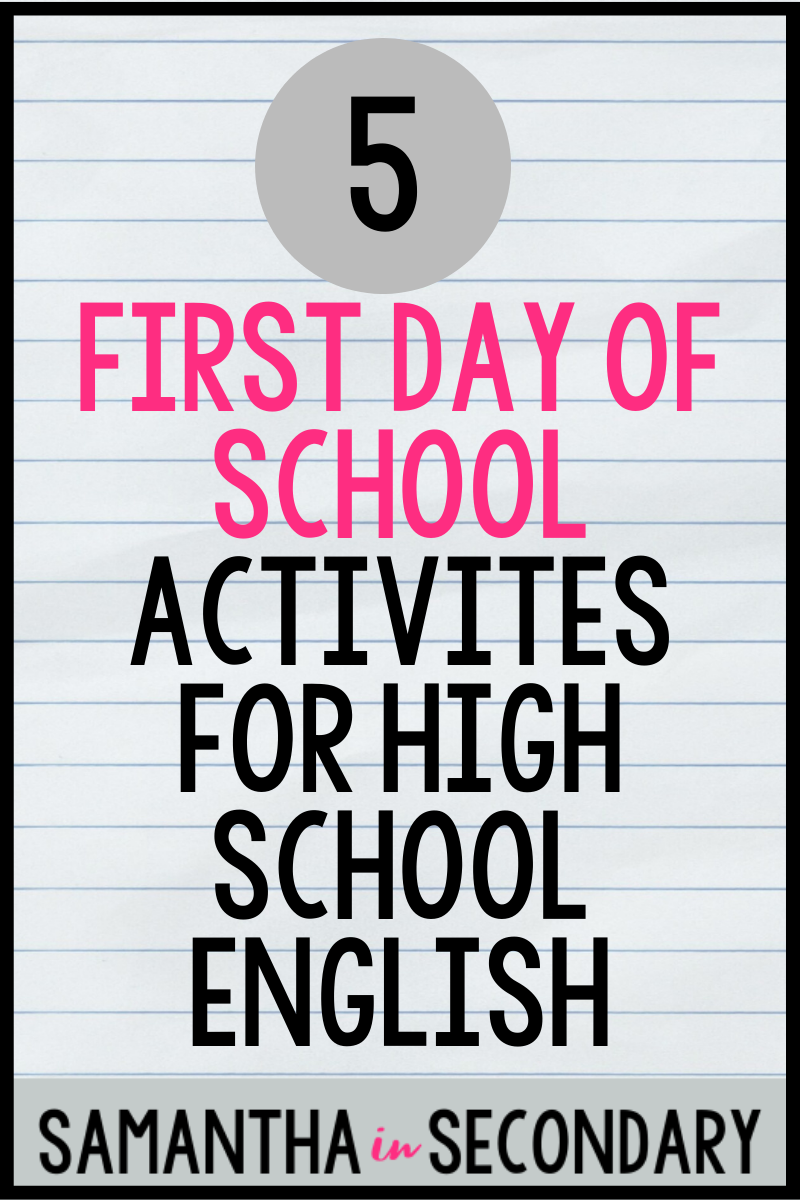
#1: Review Email Etiquette
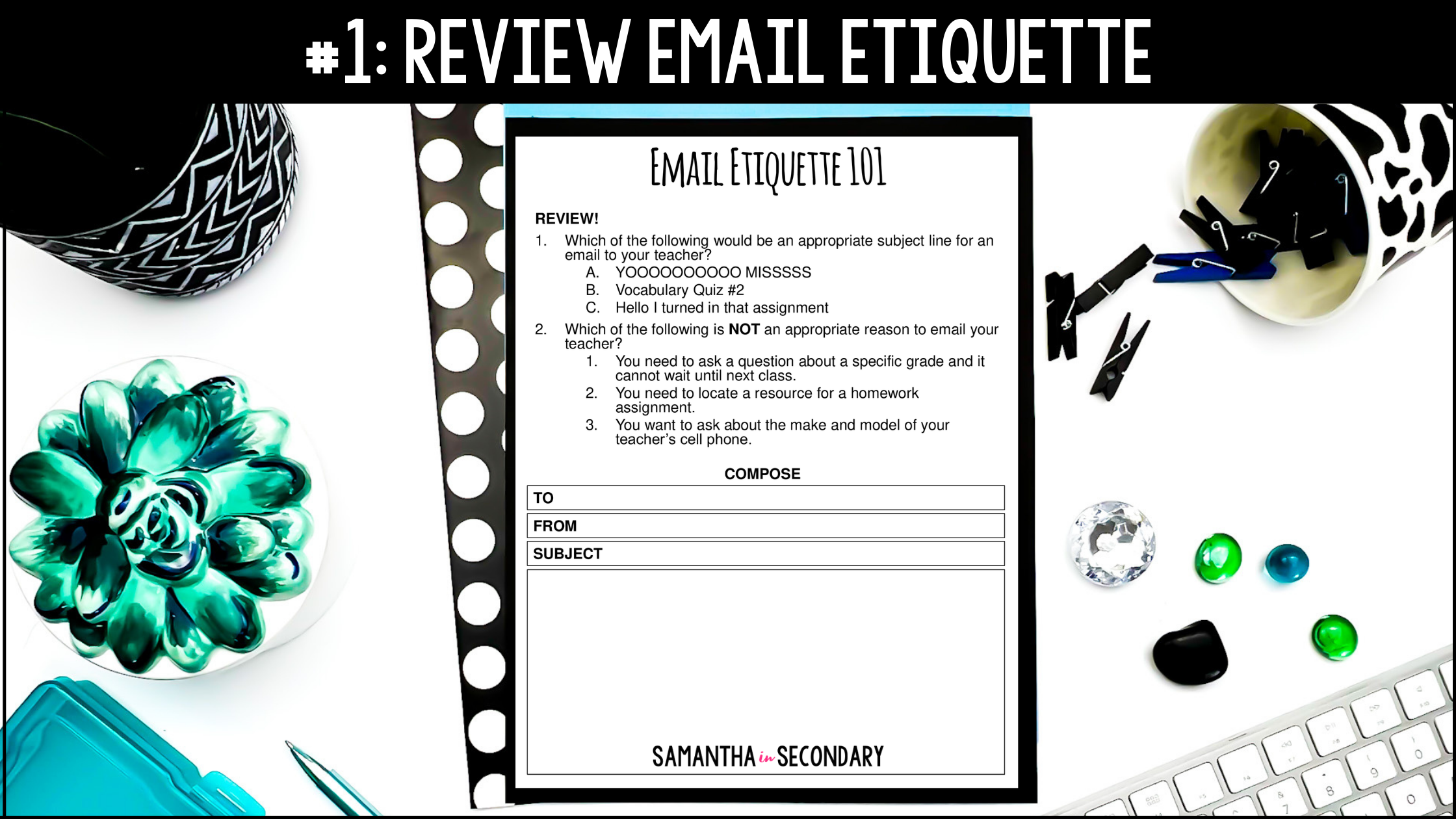
In my 15 years of teaching, this was almost always my go-to first day lesson for a general ELA classroom. You’re sneaking in a little bit of content in an engaging way, but also getting to know your students a little bit and gathering a writing sample. (They barely even notice or groan about it, either! Win!)
I first spend about 10 minutes reviewing professional email expectations. (I know you wouldn’t be shocked at how many students need this refresher!) We take a few notes, but I make sure it’s just that- a few.
Then, my favorite part, I show a good amount of examples and non-examples. We all have a good laugh at some of the poor souls who have emailed me complete nonsense in the past who are now immortalized in my presentation for future students. This is always the part students remember and sometimes I even bring them up later if a student commits any of the same offenses. I gently ask, “Hey, remember when we learned about email etiquette?” The light bulbs almost always immediately flash.
Next, I check for understanding with a little, no-stakes quiz. This is usually a good time to practice routines for technology if I decide to do this through Google Forms (which I usually do!).
Now, it’s time to practice! I have students write an email both to me and a family member. You can have them practice on paper or write actual emails to you. (I make a folder and sort them to read later.) I tell them in the email to me they MUST tell me three things about themselves. This provides a few important things: practice writing professional email, a few personal tidbits for you to learn about your students, and a writing sample. First day perfection!
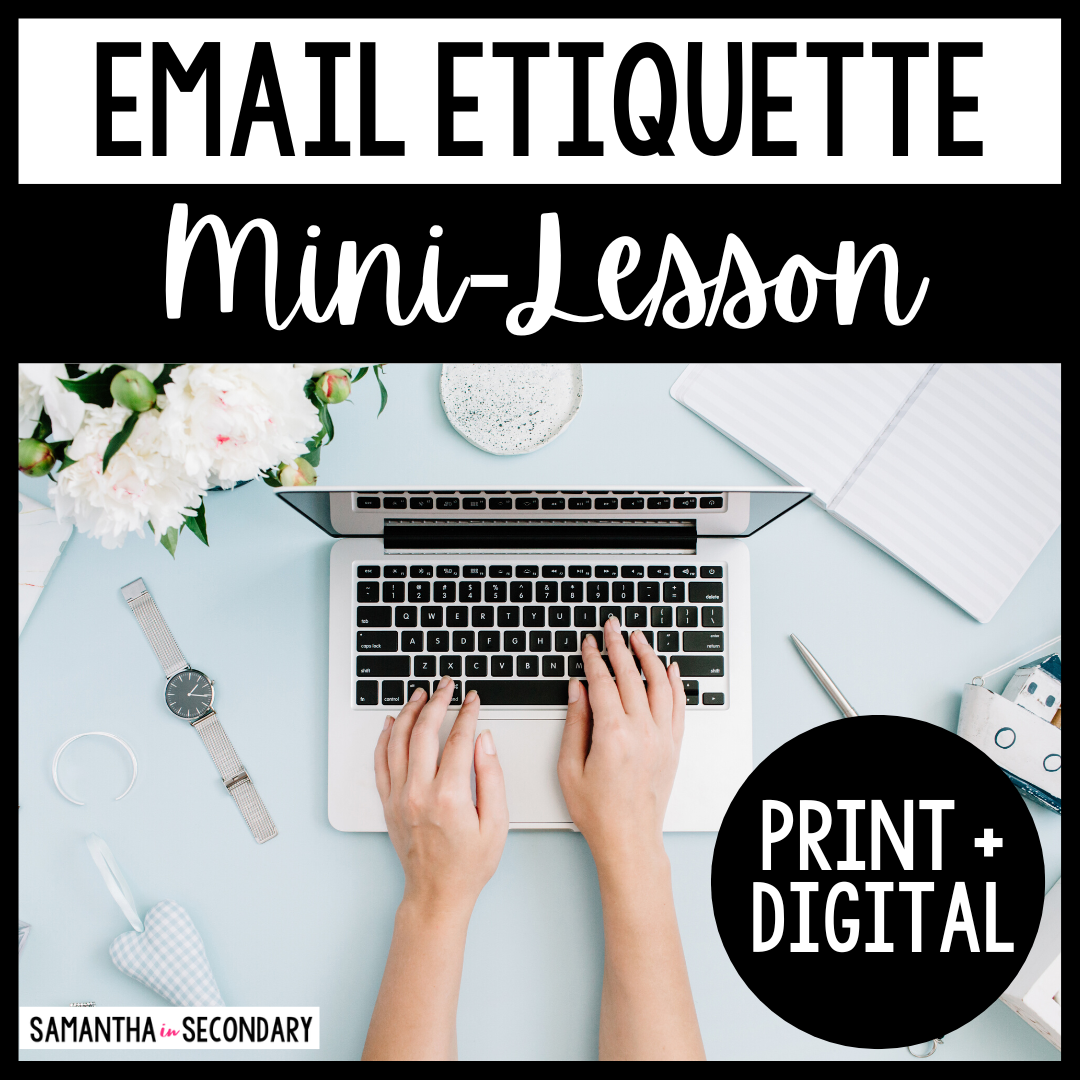
#2: Create Reader Timelines
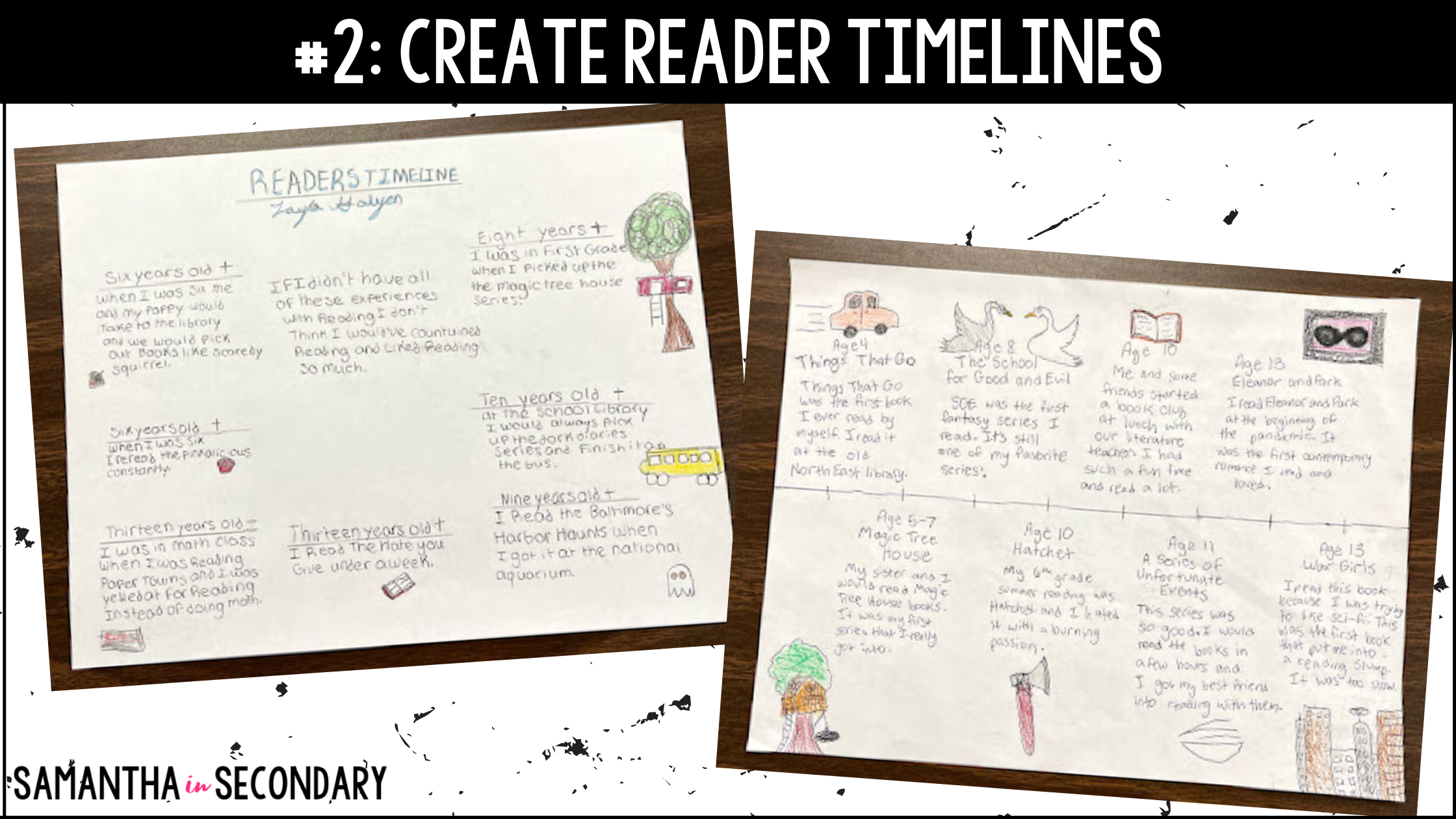
This is one of my favorite ways to open to a room full of readers. It’s especially powerful in an ELA elective course where you know you’re dealing with students who love to read. Enter: The Reader Timeline Project.
Early memories as a reader are so powerful- both positive ones and negative. Many people can identify core memories that made them into a reader (or made them hate reading!) and it can be a really compelling activity to explore them.
For this activity, have students identify a few core memories of their experience with reading. This can be particular moments, books, etc. They choose the memories and then create a timeline with images to share with the class. This can be done digitally using Google Slides or on paper with some coloring supplies. I usually give kids a choice so they can work with the medium that fits them best.
Then, have everyone share their timelines. You’ll love what beautiful discussion can blossom from reliving students’ experience with reading. Make sure to include a few memories of your own!
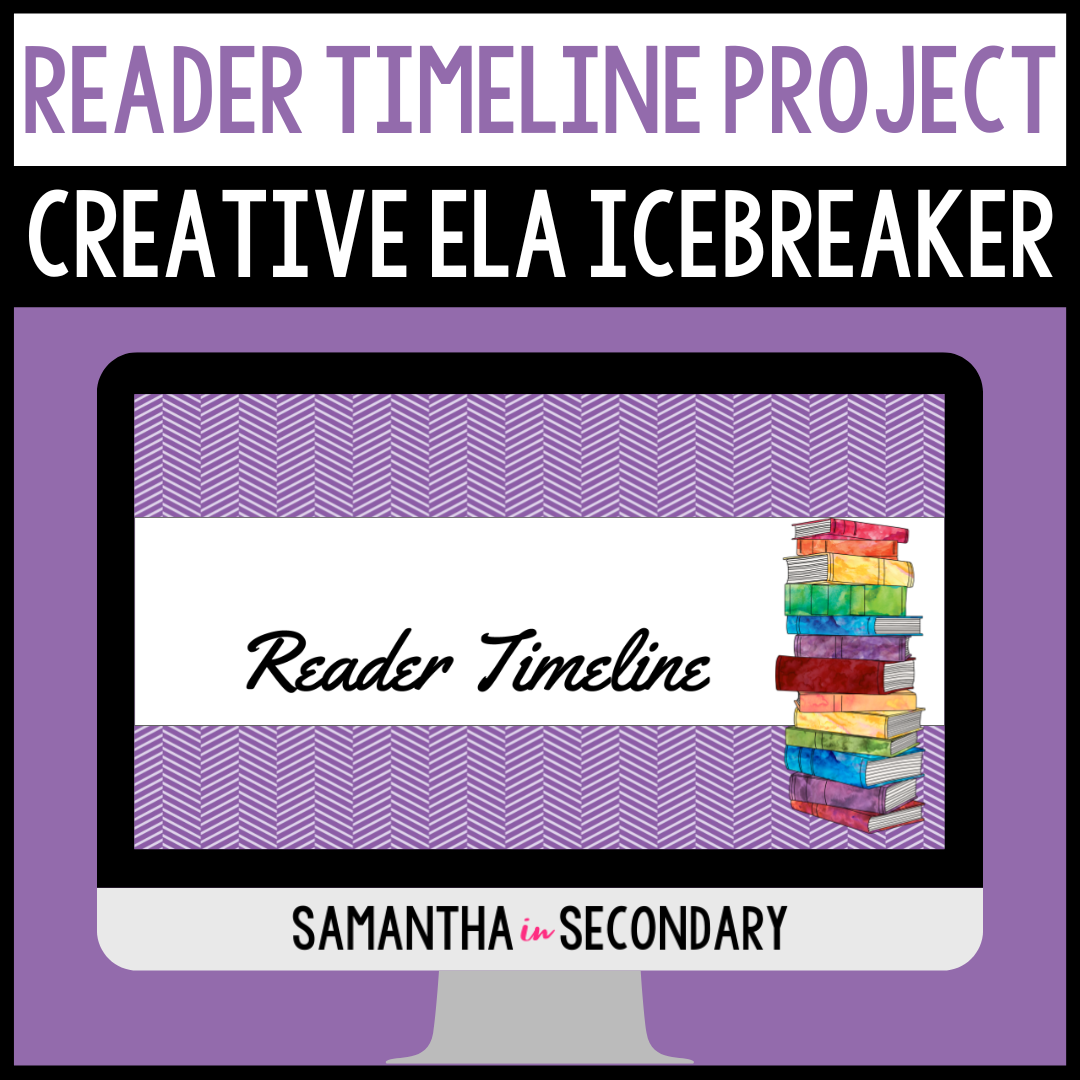
#3: Share Your Enneagram Type
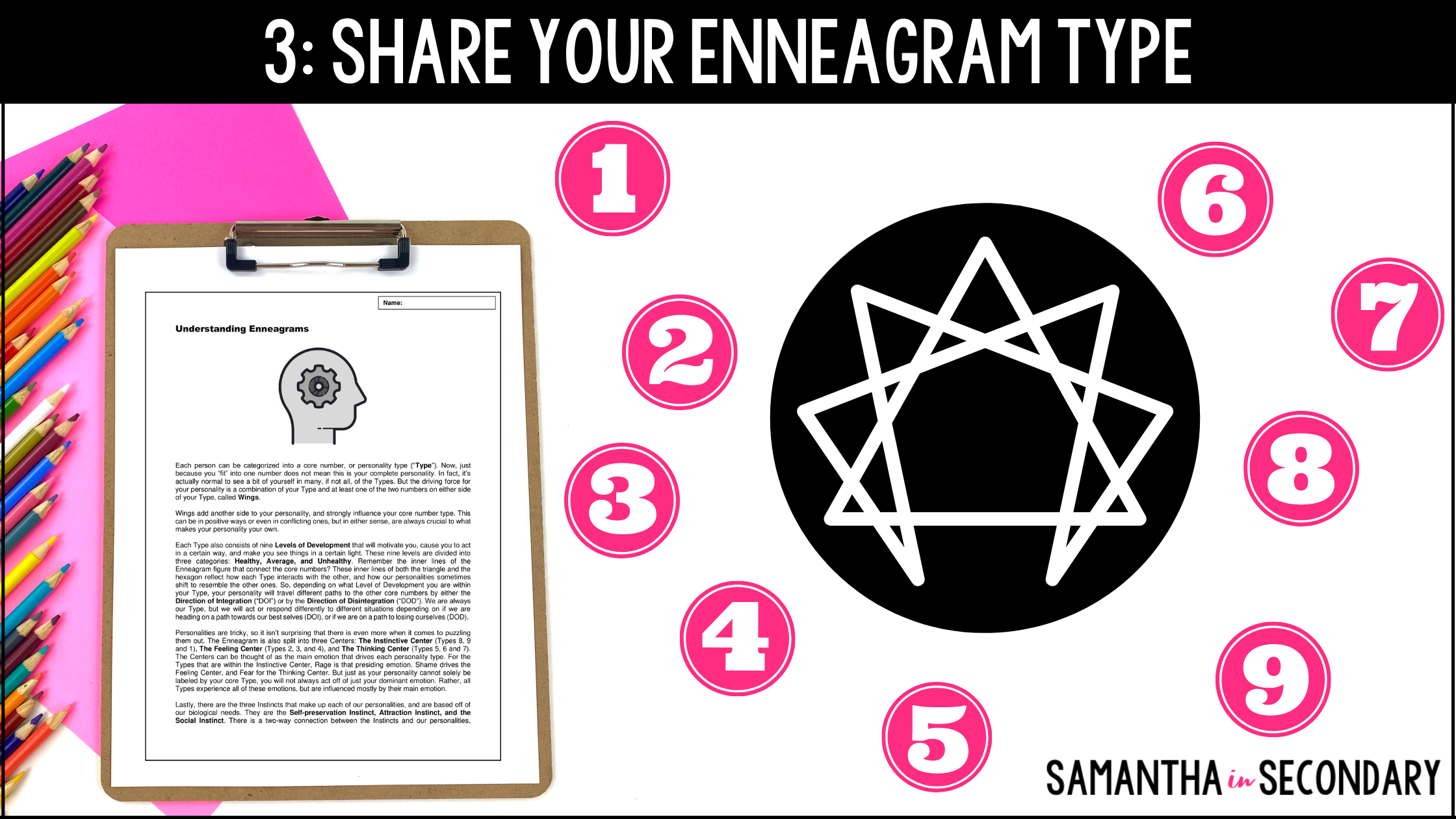
Another one of my favorite ways to introduce students to my class is with Enneagram types. (Hello, fellow 8’s!) A lot of them have a vague idea of what the Enneagram is or has heard of it before, but don’t really know any details. I make sure to include a reading with comprehension questions here so we’re definitely including some ELA skills on the first day. Then, of course, we take a quiz to find our types and share them out. I have students create a little “Enneagram profile” that connects their type to elements of pop culture.
You can check out a detailed post I wrote on the Enneagram for Angela Watson’s website, Truth for Teachers, here . You can also see my full, no-prep resource so you can implement this activity today right here .
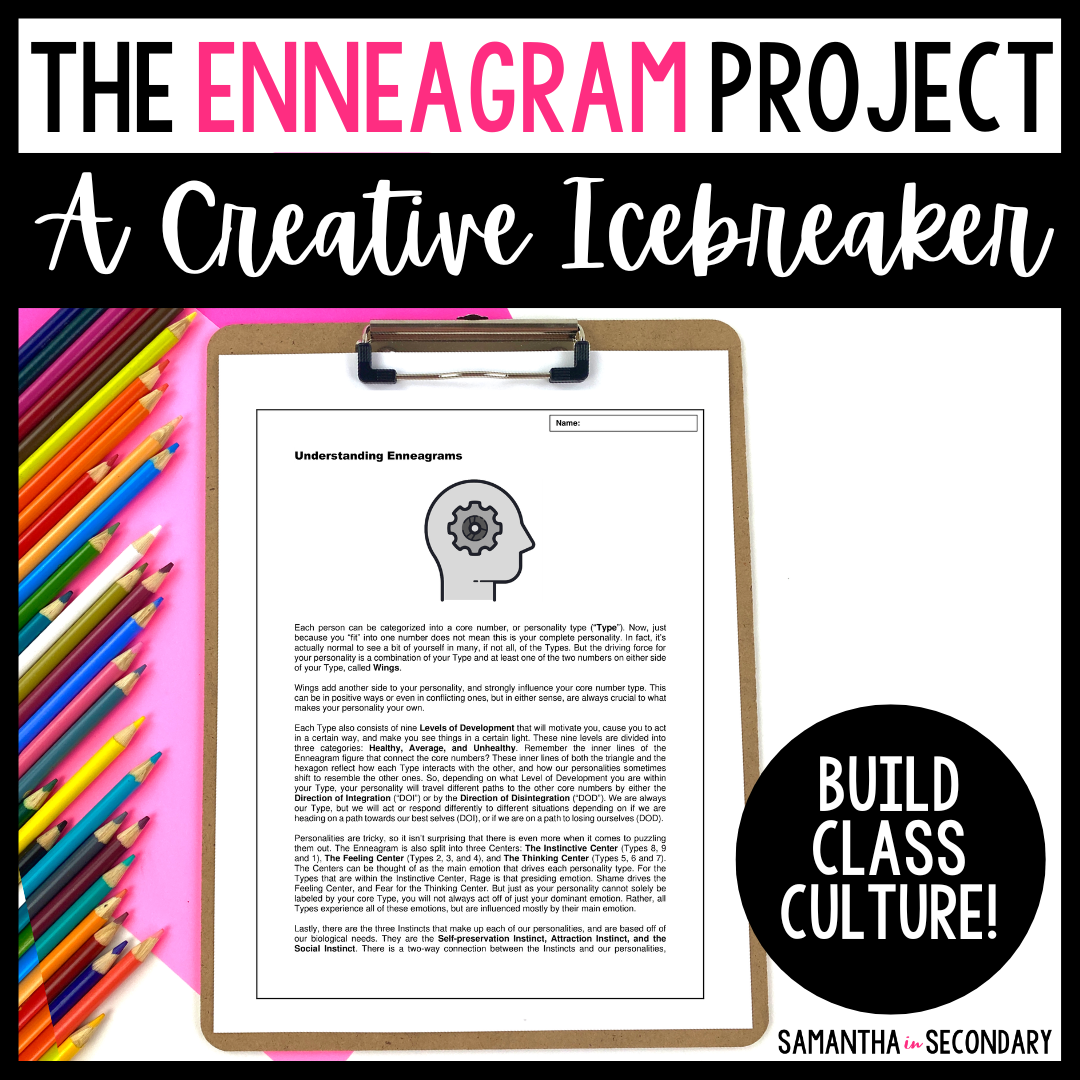
#4: Help Your Students Discover How They Learn
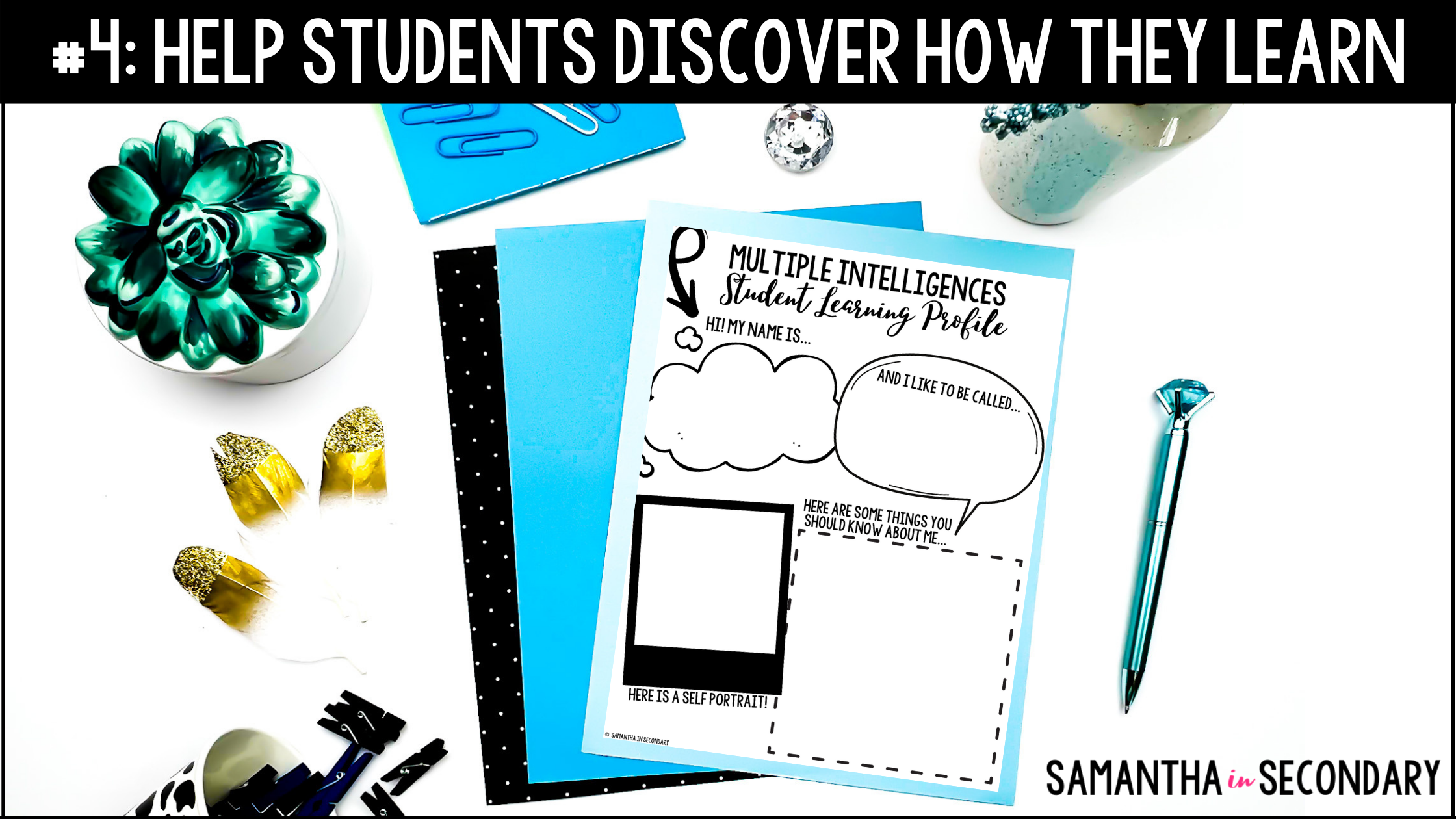
This is a newer activity in my arsenal, but it was very successful when I ran it last year. This is especially powerful if you have a remediation class or students who don’t typically view school in a positive light. Showing students that there are many ways you can be smart not only empowers them, but also shows them that you’re a safe space for them. I had many students tell me how much they loved this activity when it was done!
I call this activity the Multiple Intelligences Learning Profile Project . This project teaches students all about Howard Gardner’s Theory of Multiple Intelligences, directs them on how to find their own unique combination of intelligences, and then allows them to create their own learning profile to display their findings. Not only is this a great way to get to know your students, but you could easily make a very attractive bulletin board out of the profiles!

#5: Review Content (In a FUN Way!)
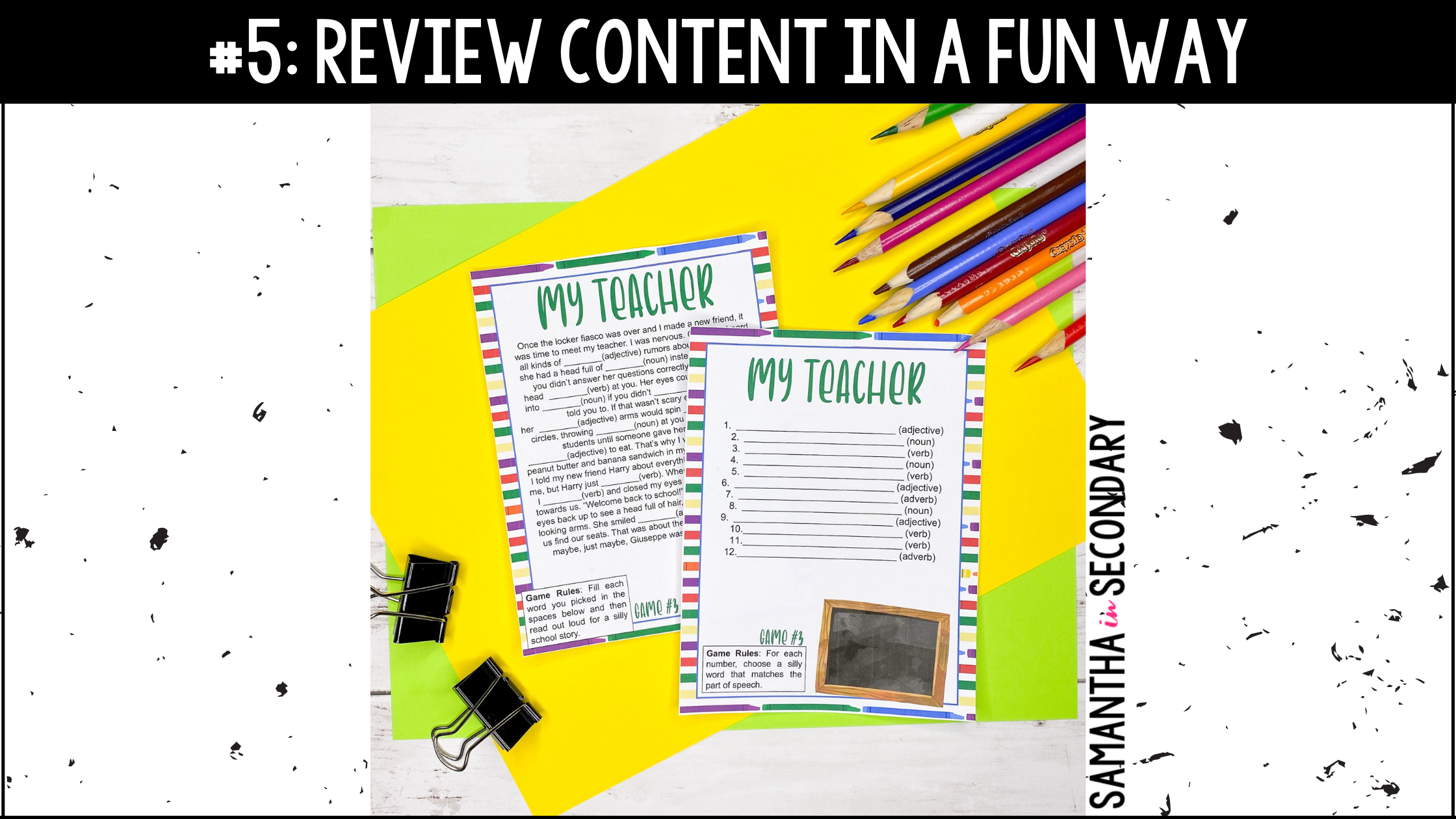
As an ELA teacher, I am always hyper aware of how content-specific language students forget over the summer. One of the first things I do is usually take it WAY back and review parts of speech. (Even with my upperclassmen sometimes… #iykyk)
An easy way to do this is with my Silly Stories resource (just like Mad Libs). Students think you’re just doing something fun when really you’ve found a sneaky way to make sure they remember terms they need to know. This is a great activity to have in your back pocket any day, but it’s especially handy for a first day block. (Those last 15 minutes can be killer when you’re re-adjusting your pacing!) Grab a few sets and print them off just in case.
You can do something similar with ANY content. Review games or escape room activities are also great ideas.
What’s your favorite way to introduce your students to your class? Sound off in the comments below or follow me on Instagram or Facebook to join the conversation!
Happy teaching!

Subscribe to the newsletter to keep up to date on all things Samantha in Secondary.
🎉 Our next novel writing master class starts in – ! Claim your spot →
BEST HIGH SCHOOL WRITING PROMPTS
Join (probably?) the world's largest writing contest. Flex those creative muscles with weekly writing prompts.
Showing 103 prompts reset
Set your story at a wedding reception, where a group of high school friends are meeting for the first time in years., write a story about an unconventional teacher., what was the last daydream that you dreamt while in class (be honest.) turn that into a short story..
High School
Write a story inspired by your favorite Tiktok reel.
You're trapped on a version of groundhog day... and the day that keeps looping for you is the day right before summer break starts..

Introducing Prompted , a new magazine written by you!
🏆 Featuring 12 prize-winning stories from our community. Download it now for FREE .
Write a letter to your middle school self. What would you want them to know?
Interview your favorite fictional villain. what questions would you ask them, you have to escape from a house on fire. what are the first three things you grab why, explain a computer to someone from the 16th century., define what trust means to you., subscribe to our prompts newsletter.
Never miss a prompt! Get curated writing inspiration delivered to your inbox each week.
Write a letter describing yourself and your modern life to a pen pal who lives in the year 1905.
What's your first memory describe it on paper using all five senses., write a guidebook for someone from outer space who is visiting your neighborhood for the first time., re-write a famous fairy tale from the villain's perspective., would you rather be able to change the past or change the future why, write about a time when you did something without thinking it through., if i were a superhero, i would..., describe the color blue to someone who's never seen it before., write a story that takes place completely in the dark., write an essay about technology, and the role that it plays in your life., win $250 in our short story competition 🏆.
We'll send you 5 prompts each week. Respond with your short story and you could win $250!
Contest #253 LIVE
Enter our weekly contest.
This week's theme: Slow Down
Prize money
Contest entries, closes at 23:59 - jun 07, 2024 est, recent contests ✍️.
#252 – Obsession
#251 – Lost and Found Books with BookTrib
#250 – All Ears
#249 – Action Stations with Tom Bromley
Recent winners 🏆
Adam Perschbacher – read
VJ Hamilton – read
Dena Linn – read
Honey Homecroft – read
Leaderboard 🥇
#1 Zilla Babbitt
32375 points
#2 Deidra Whitt Lovegren
28742 points
#3 Abigail Airuedomwinya
22421 points
#4 Graham Kinross
14540 points
#5 Scout Tahoe
13199 points
#6 Chris Campbell
11415 points
#7 Thom With An H
10645 points
#8 Rayhan Hidayat
10213 points
#9 Michał Przywara
9946 points
#10 Deborah Mercer
9610 points


Bring your stories to life
Our free writing app lets you set writing goals and track your progress, so you can finally write that book!
The best writing prompts for high school
Ah, high school. The birthplace of future geniuses, the setting of a million Young Adult books — and the cutting ground of many a brilliant young author. Writing in the classroom is often the best outlet of creativity for kids, and what better way to get your students excited about it than through creative writing prompts for high school students?
Whether you use journal prompts or story ideas to kickstart your high school student’s imagination, writing prompts are sure to help broaden their thinking, sharpen their writing skills, record their thoughts, and get them to engage with the world around them.
If you're looking to cut to the chase, here's a top ten list of writing prompts for high school students:
- In the form of diary/ journal entries, write about someone who's just experienced a big "first."
- Just then, your phone rings. It's your friend and they have some interesting news...
- Write a short story where the protagonist has a doppelgänger.
- Write a story about a misunderstanding.
- Write a story about a strange family tradition, with at least two characters from the family narrating in the course of the story.
- Write a story about someone who would be described, above all else, as: kind.
- Write a story that centers on an Instagram post.
- Write a story that spans a month during which everything changes.
- Write about a group of people determined to win an award for making the biggest cookie ever.
- Write about someone going to extreme lengths to return an overdue library book.
If you have a high school student who’s interested in becoming an author, check out our free resources on the topic:
Develop a Writing Routine (free course) — Any high schooler who’s serious about becoming a published author should know that writing a book doesn’t just take talent. 90% of the process is sitting in front of a blank piece of paper, and having the drive and commitment to put words to paper. That’s why we created this free course, which shows people of any age how to develop a writing routine that works for you. It’s never too early to start the process today!
Want to encourage your high school students to start writing? Check out Reedsy’s weekly short story contest , for the chance of winning $250! You can also check out our list of writing contests or our directory of literary magazines for more opportunities to submit your story.
NEW VIDEO COURSE 🎉
How to Write a Novel
Join Tom Bromley for a writing master class and finish your first draft in 3 months . Learn more →
Explore more writing prompt ideas:
Adults Writing Prompts ⭢
Adventure Writing Prompts ⭢
Angst Writing Prompts ⭢
Character Writing Prompts ⭢
Christmas Writing Prompts ⭢
Dark Writing Prompts ⭢
Dialogue Writing Prompts ⭢
Dramatic Writing Prompts ⭢
Dystopian Writing Prompts ⭢
Fall Writing Prompts ⭢
Fantasy Writing Prompts ⭢
Fiction Writing Prompts ⭢
Fluff Writing Prompts ⭢
Funny Writing Prompts ⭢
Halloween Writing Prompts ⭢
High School Writing Prompts ⭢
Historical Fiction Writing Prompts ⭢
Holiday Writing Prompts ⭢
Horror Writing Prompts ⭢
Kids Writing Prompts ⭢
Middle School Writing Prompts ⭢
Mystery Writing Prompts ⭢
Narrative Writing Prompts ⭢
Nonfiction Writing Prompts ⭢
Novel Writing Prompts ⭢
Poetry Writing Prompts ⭢
Romance Writing Prompts ⭢
Sad Writing Prompts ⭢
Science Fiction Writing Prompts ⭢
Short Story Writing Prompts ⭢
Spring Writing Prompts ⭢
Summer Writing Prompts ⭢
Teens Writing Prompts ⭢
Thanksgiving Writing Prompts ⭢
Thriller and Suspense Writing Prompts ⭢
Valentine's Day Writing Prompts ⭢
Vampire Writing Prompts ⭢
Winter Writing Prompts ⭢
Oops, you need an account for that!
Log in with your social account:
Or enter your email:
- Our Mission
4 Engaging Writing Tasks for High School Students
Short, authentic writing tasks can encourage high school students to compose richer long pieces.

It’s quite likely that many of your students dislike writing. After all, they’re often expected to compose lengthy pieces that typically require lots of brainstorming, researching, planning, outlining, drafting, revising, and editing—and that can be exhausting. My class of high school boys had the same attitude, and their short, underdeveloped, and passionless pieces were most telling. I had to overhaul my approach.
During my quest for an alternative practice, I quickly learned that by building students’ knowledge about the topic on which they are expected to compose, and by initially assigning them shorter and more authentic writing tasks, we can successfully motivate them to write longer, richer, and more compelling multiparagraph pieces. Yes, baby steps—from a creep to a stable walk—can work wonders.
Incorporate Knowledge-Building Activities
Judith Hochman and Natalie Wexler said it best in The Writing Revolution: A Guide to Advancing Thinking Through Writing in All Subjects and Grades : “Writing and content knowledge are intimately related. You can’t write well about something you don’t know well. The more students know about a topic before they begin to write, the better they will be able to write about it.”
Documentaries, podcasts, TED Talks, and other authentic and engaging audiovisuals can facilitate this knowledge building. Field trips, as well as interviews with relevant community-based experts, can also offer students significant fodder for their writing.
Moreover, when students have interesting discoveries to share, they’ll be excited about the writing tasks, and their compositions are likely to be longer, more detailed, more affecting, and more compelling. Because they have a rich knowledge bank, they’re less likely to get stuck and frustrated as they write. Knowledge stimulates ideas.
But information gathering is not all. It’s also important to show students how to use the newly learned content. We don’t want them to plagiarize information or inadvertently silence their own voices by over-quoting others. Their research should enhance what they write, not substitute for their initial thoughts or suppress their creativity.
What can you do then?
Go beyond lessons in citation format. Model, through write-aloud, how to make decisions about the content included in written work, how to paraphrase and summarize from the original source, and how to ensure that the added content actually strengthens what you already have.
Offer Authentically Rooted Writing Assignments
Finally, make sure that the writing assignments are authentic—with realistic, real-world communicative goals and true-to-life audiences (not just the classroom teacher). Here are some suggestions that you can implement in your teaching practice:
Travel blogs: Take students on virtual field trips. Nearpod , Google Earth, and YouTube are excellent for this. Following this activity, have students write a blog post to describe the place they visited. If your students have visited resorts or attraction sites locally, they could write about that experience, recommend activities for prospective visitors, and simultaneously persuade them to visit when it is safe to do so.
Their insights might even persuade others to travel to this site. Students could use pictures to supplement their writing. They could also convert their written piece into a mini-video production for a real or imagined YouTube channel that promotes exotic getaways. Their composition would become the audio narration, and, with some background reggae, R & B, or any other culturally popular music, their piece would be beautifully transformed into a riveting marketing pitch.
Movie reviews: Due to the pandemic, we know that many of our students may be watching far more movies than ever before. Therefore, let’s repurpose this social activity and use what they love or do for pleasure to help them refine a key academic skill. Have students write a review of their most recently watched or favorite film.
Prompt them to provide a summary of the movie, share their impressions of major characters and the plot’s unfolding, and examine the techniques used to create suspense and mounting tension. Later, when they’re writing their own narratives or putting on drama productions, they can adopt and adapt some of these techniques.
Song or music video reviews: Some students enjoy listening to music, so a song or music video review could also motivate them and facilitate interest-based differentiation. State where the review may be published—a local tabloid, a social media page, etc. Have students keep that in mind as they write so that their finished pieces are authentic and fitting for the context and audience intended.
Social media: Based on your content area, you could have students make discipline-specific posts and write related captions. For instance, if you are looking at rocks in geography or soil types in science, have students photograph different types and post related descriptive or explanatory captions. They’ll be learning and teaching concurrently.
Provide Mentor Texts
These activities are exciting, but before you scuttle off to assign them, find or create models of the kinds of writing that you want your students to produce. Discuss the sample by prompting students to keenly attend to the content and the writer’s craft (style and techniques) throughout the piece.
Finally, make arrangements to have your students publish their pieces—through a safe online space or through an in-school magazine or newsletter—for authenticity at its finest.

Back to School Writing Prompts for the Secondary Classroom
With the new school year on the horizon, here are some helpful back to school writing prompts to use with your new students!
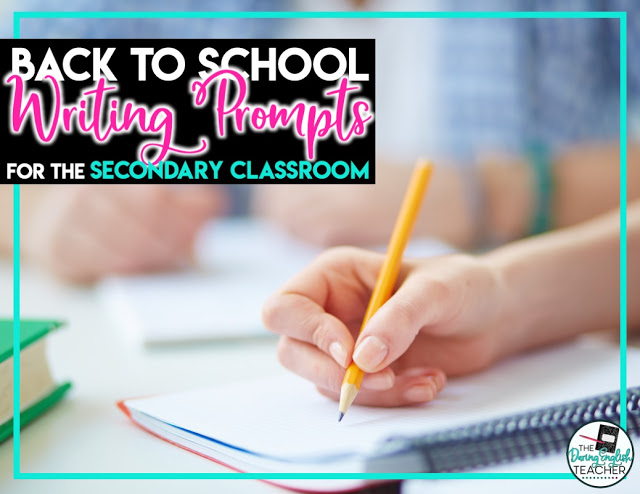
Assigning a personal narrative at the beginning of the school year doesn’t have to mean assigning a full, five-paragraph essay. These personal narratives can be anywhere between a sentence long to several paragraphs. Here are some of my go-to back-to-school writing prompts for secondary students.
Back to school writing prompts about summer break.
- What did you do over summer break?
- What was your favorite thing about summer break?
- What was your least favorite part of summer break?
- What song best represents your summer break and why?
- What movie best represents your summer break and why?
- What life lessons did you learn over summer break?
- What accomplishments did you achieve over summer break?
- What hardships did you experience over summer break?
Back to school writing prompts about last school year.
- What was your favorite thing about school last year?
- What was your least favorite part about school last year?
- What class was your favorite and why?
- Which class did you struggle with the most and why?
- What life lessons did you learn last school year?
- What accomplishments did you achieve last school year?
- What hardships did you experience last school year?
- What obstacles did you face last school year and how did you overcome them?
Back to school writing prompts about this school year.
- What are your goals for this school year?
- What is the most frightening thing about a new school year?
- What is the most exciting thing about a new school year?
- What are you most excited about this year?
- What are you dreading about this school year?
- What current obstacles or hardships are you facing this school year?
- As your teacher, how can I best help you succeed in my classroom?
- What do you want me to know about you?
Back to school writing prompts about life in general.
- What is your most cherished childhood memory? Describe the event/memory in detail.
- What is the biggest challenge you have ever faced? How did you overcome this obstacle?
- What is your life dream and how do you plan to achieve it?
- Describe the most frightening moment of your life.
- What are you most proud of and why?
- What is a typical day in your life like? Explain in detail.
Back to School Resources for the Secondary Classroom:
- Digital Back to School Stations
- Back to School Activities
- Growth Mindset Activities
Subscribe to my email list.
Subscribe to receive freebies, teaching ideas, and my latest content by email.
I won’t send you spam. Unsubscribe at any time.
Built with ConvertKit
One Comment
Thank you so much for this list of writing prompts! It will help me tremendously!
Leave a Reply Cancel reply
Your email address will not be published. Required fields are marked *
Save my name, email, and website in this browser for the next time I comment.

SUBSCRIBE NOW
- Join Membership
- English Teacher Vault
- What's Included
- Try Out Free Lessons
- Yes, I'm Ready

Want An Outstanding First Day of School Activity for Your High School Students?
I have had thirteen first days of school as an English teacher, probably a dozen or so first days as a tutor, four or five as an ESOL teacher, and a few more sprinkled throughout my lifetime. So when I say, I have had a range of first day experiences, I am not kidding. Some of those days were GREAT! Some, well, not so great.
My Worst First Day of School Lesson
My worst first day of school was actually one in which I presented a lesson that I had actually spent a lot of time and thought preparing. I had been so inspired by a certain book that I flew across the world to an orphanage in Nepal and volunteered my summer working with the orphans of Kathmandu. It was all because of a book, and I wanted to share that with my (brand new) students. I wanted them to get a glimpse of how powerful books can be, and how, if you let them, they can change your life.
Well, the lesson fell flat. Real flat. These 15-year-old students were bored out of their minds watching my Power Point presentation of orphans across the world. They didn’t really care what I did over the summer. They didn’t even know me. What they cared about (which I didn’t process until later) didn’t have a whole lot to do with me at all.
What Students Are Thinking About That First Day
What most likely was on my students' minds was whether or not my class would be hard, whether or not I’d be a jerk, and whether or not they got the lunch period with their friends.
I should have saved my inspirational speech for some other time, maybe a day when I brought donuts, or perhaps the last day of school, when they actually knew I cared about them and wasn’t a jerk.
Since that day I have learned A LOT about what works and what doesn't on the first day of school.

How To Do The First Day of School Well
Be sure you're intentional about setting a tone.
The first day of school sets the tone for your class, so the first-day-of-school activity has the potential to relay what you value. Just like we want students to “show” and not “tell” in their writing, we should “show” and not “tell” them what matters to us in our classroom.

Spend Only 10-15 Minutes On Your Syllabus
For this reason I suggest that teachers should not spend that first class period going over every painful detail of your syllabus. Spend 10-15 minutes on your syllabus. Hit the high points. Remember, they're going to listen to five or six other lectures detailing syllabi that day.
If you make an infographic syllabus like this one you can zip through the syllabus, and your students' eyes will naturally go to the most important parts. Or, try this FREE template from Yaddy's Room , which is the one featured in the image below.
Spend only a few minutes on your syllabus, then, spend the rest of your time on a meaningful activity that allows you to get to know your students in a low-stakes capacity and sets the tone for what matters in your classroom.
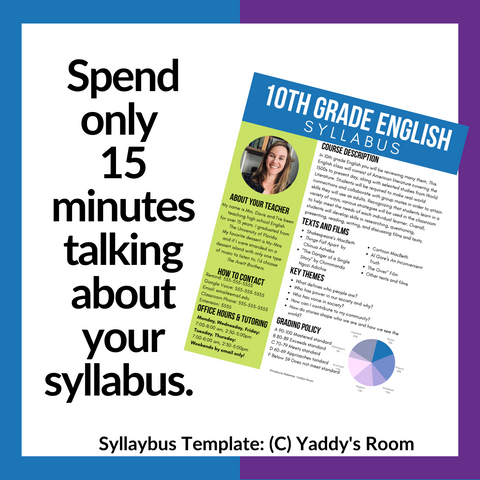
Have Students Make Name Plates, And Require They Bring Them Back
After spending a few minutes on your syllabus, give students each a sheet of card stock, have them fold the cardstock in half (hot dog style), and then have them write their names in large letters on the card stock. They can put these on the front of their desks, and you can take a picture of each student with their name plate, so you can study up those first few days. I have students bring these name plates and put them out every day for the first week, and then I'll study their pictures with them holding up the name plates when I can.
Betsy Potash has a great take on the name plates, and you can see what she does here: "The First Day of School Doesn't Have to Be Boring ."
Give A Meaningful, Structured, Writing Activity
Next, move on to the main thing for the class period. The best first day of school activity I have found for my students is for them to write about themselves. It sounds simple, but it pays dividends those first few weeks of school.

An Autobiographical Option
I find that giving students an opportunity to tell their teacher about themselves at the beginning pays huge dividends, especially that first month when you are establishing rapport.
- I give students a handout with questions about their history as a reader and their history as a writer.
- I tell them that they don’t have to answer all the questions, just as many as they feel like.
- I also tell them that I’m trying to get a sense of who they are because I shape my class around my students. I tell them I’m also trying to see what type of writer they are. This helps me as I prepare our grammar and writing curriculum. I basically set the tone that they are helping me, and they’re helping themselves by taking the assignment seriously. This shows them that I am not a jerk; I'm a teacher who cares, but also this class is serious, and we are going to write in here.
- I give them the remainder of the period to just write. Sure, it's quiet, and it may seem like a long time to have them write. But some students LOVE having that chunk of quiet at some point in a very exciting/stressful first day.

A Creative Writing Option
An alternative to having students write about themselves is to give them a creative writing opportunity. Here’s how you can set this up:
- Give each student an envelope including 6-8 intriguing pictures.
- Tell them to open the envelope and choose at least 3 pictures from it.
- Tell them to spend the remainder of class (after you’ve spent 10-15 minutes on your syllabus) writing the beginning of a creative story that includes what’s in 3 of those pictures
- Have students turn in whatever they’ve completed by the end of class, or allow them to bring it back the next day.
This activity is great because it’s
- Gives you a sense of your students’ writing abilities on the first day of school

Do not grade the first day of school activity
I love doing writing assignments on the first day of school because it takes the pressure off of me to perform. It also allows me to get a glimpse of their writing from the very beginning which is useful as I begin planning
But please, do not grade these. They are intended to be low stakes. They are intended for you to get to know your students.
What I like to do is print out a sheet that allows me to quickly jot down notes for each students writing in that class. I can make check marks detailing their depth of thought as well as their grammar and writing. This gives me a quick snapshot of the class as a whole which helps me as I prepare our grammar and writing instruction.
If nearly the whole class struggles with run on sentences, that's good to know from the beginning.
Want To Give It A Try?
If you'd like to try this exact lesson, I've set it all up for you, including the notes/grading sheet (remember, you're not really grading these).
When you join the English Teacher Vault, you get this lesson plus over 100 more resources. It's all customizable, so that you can make it your own, or just use it exactly as it is.
Click the image below and rest easy knowing the first day of school activity will set your students at ease and relay what matters in your classroom: your students and their success.

A few more outstanding first-day-of-school activities
I recently ran across this lesson plan from NY Times, "What's Your Reading History? Reflecting The On Self as a Reader," and I think it would work great on the first day especially if you had a group of students who already know you. If, for example, you have a group of seniors that you also taught as sophomores, I think this could work great.
My friend Jeanmarie has some great ideas for the first few days of school, but they can really be used any time in the school year to connect with students. You can check those out on her post: 5 Back To School Units For High School English.
Beyond The First Day
While this is a great way to start your school year and to see where your students are with their writing, after the first day you'll need to tackle some of those writing struggles.
I've put together two consecutive years of grammar curriculum for secondary students as well as writing resources, literature resources, and more back-to-school activities that you can access immediately when you join the English Teacher Vault. Check it out here .
Want to check out my method for teaching grammar and see if it works with your students, plus have your first grammar unit totally done for you?
Grab my FREE parts of speech unit here .

Here's to a great first day this year. Remember what your students have on their minds, and show them what your class will be about and what you value through that first-day-of-school activity.
Related Reading
High School English Teachers, I Planned Your First Week Back
After 12 Years Of Teaching, I Found Norms Are Better Than Rules, Here's Why
Shop This Post
First-day-of-school Activity For Highschool
Free Parts of Speech Unit
Join the English Teacher Vault

Are you a teacher interested in getting started in blogging? Learn how here: 7 Tips on How to Blog Like a Boss.
Thanks so much! The first day can be so stressful and your lesson looks amazing! Thank you for sharing :)
Leave a comment
Please note, comments must be approved before they are published
Want a free unit plan?
Yes! Send me the parts of speech complete unit!

- Mathematics
- Reading and Writing
- Intervention
- Professional Learning
- Virtual Events
- What is Phonics?
- Teaching Grammar
- Vocabulary Games
- What is Virtual Learning?
- About Sadlier
- Find a Sales Representative
- International Distributors
- International Programs
- Online Catalogs
- Sadlier School Site Map
- Pricing & Ordering Information
- Sadlier’s W-9
- Sadlier’s Sole Source Letter
- Sadlier’s Credit Application
- Privacy Policy
- Return Policy
- Terms & Conditions
Sadlier's English Language Arts Blog

- Author Interviews
- Interactive Read Alouds
- Close Reading
- Vocabulary/Vocab Gal
- Writing with Vocabulary
- Assessments
- Charts/Posters
- Graphic Organizers
- Back to School
- End of School
- Classroom Management
- Grammar & Writing
- Thinking Routines
- About Our Bloggers
August 12, 2022 CG Writing Lessons 9-12 , CG Writing Lessons K-5 , CG Writing Lessons 6-8 , ELA K-5 , ELA Seasonal Back to School , ELA 6-8 , ELA Resources - Activities , ELA Focus - Writing , ELA 9-12 , Core Grammar
Back-to-school writing prompts [includes printable worksheets], by: tiffany rehbein.
Use simple back-to-school writing prompts to assess writing skills and learn important information about each student in your room!
Individual Back-To-School Writing Prompts
Writing assessment comes in many forms, and here are 10 prompts to get your students writing.
Write about going back to school after summer vacation.
Five years from now I will be …
Write a list of 10 things that make you feel good.
Describe your favorite day.
Tell about your favorite weather.
Describe an outdoor game you like to play.
Imagine that you are an animal in the zoo. What type of animal are you? How do you feel about your home in the zoo? How do you feel about people that visit and watch you?
If you could visit any place, where would it be and why?
Draw yourself as a superhero. Write about the personality traits you would have.
As I approached the school on the first day, I saw …
If you would like to extend these writing prompts, download my Letter Writing Prompt Activity . With this activity students will pick a prompt and then write a letter about that topic. Have students practice writing a draft and revising, for a nice, clean final copy. Then instruct students to use the letter template in the Letter Writing Prompt Activity to write their final draft. These final letters can be posted in the classroom or hallway to celebrate your student's writing.
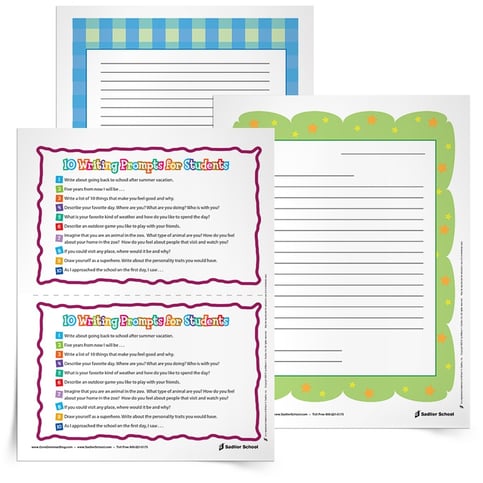
Collaborative Back-to-School Writing Prompts
Using small groups or the whole class, here’s a fun way to write collaboratively!
Each student needs a pencil and a piece of paper that is out of their notebook
Post As I approached the school on the first day, I saw … on the overhead projector or white board
Have each student write the opener and add to it. You can put a time limit on the writing or a quantitative number (e.g., write 3-5 sentences)
After they have written, have the students pass their paper to the person in front of them
Students will read the new paper and add to it (again with a time or sentence limit)
Repeat steps 4 and 5 based on your time frame
Write a conclusion! At this point, you will have an introduction and some body paragraphs. To reinforce writing conclusions, verbally tell the students to write a solid conclusion, wrapping up the story.
Have one student read the story to the entire class to share the creative event!
These back-to-school writing prompts build classroom community, gives students an opportunity to write in an engaging, collaborative manner, and gives you valuable feedback to you about each student’s writing.
Additional Back-to-School Writing Ideas
Don't forget to check out my Who Are You? Writing Prompt . This is a great worksheet to use occasionally throughout the year to show your students you are always interested in their interests... not just during the first few weeks of class.
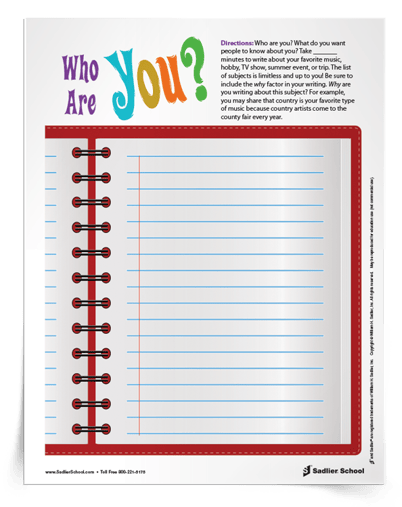
hbspt.cta._relativeUrls=true;hbspt.cta.load(95641, '650c53c6-6aaa-4140-a5f2-a30a4681f873', {"useNewLoader":"true","region":"na1"});
Looking for additional writing prompts you can use throughout the year? Below are three downloads that will be great additions to your teaching tool kit.
First Day of School Activities for High School English, Fun Writing Assignment

- Google Apps™
- Easel Activity
What educators are saying
Also included in.

Description
This back to school writing assignment for high school English classes will help build classroom community as students create beautiful personal mandalas with descriptive anecdotal writing. With three days of detailed lesson plans, students learn about classical Indian mandalas, develop symbols representative of themselves, write explanatory paragraphs, and create a polished product to present to their classmates. During the entire process, students share ideas with one another and get to know each other. This assignment is perfect for your first week of school! Includes a student version in Google Drive.
⭐ WAIT! This is included in my Complete Back to School Pack
⭐ Also, check out my Icebreaker Pack for Secondary Students
⭐ Please visit my store for engaging units and other teaching materials: Love and Let Lit
⭐ Check out my top selling resources by clicking the links below:
Romeo and Juliet Reading Guide Bundle
Three Week Poetry Unit
Expository Essay Unit
⭐ How to get TpT credit to use on future purchases:
• Please go to your My Purchases page. Beside each purchase you'll see a Provide Feedback button. Simply click it and you will be taken to a page where you can give a quick rating and leave a short comment for the product. Each time you give feedback, TpT gives you feedback credits you can use to lower the cost of your future purchases. Thank you!
⭐ Be the first to know about my new discounts, freebies and products:
• Look for the green star next to my profile picture and click it to become a follower. You’ll receive updates when I post products, freebies and discounts.
Created By: Jacque Decker of Love and Let Lit
Questions & Answers
Love and let lit.
- We're hiring
- Help & FAQ
- Privacy policy
- Student privacy
- Terms of service
- Tell us what you think

Creative Writing Unit for High School Students

My creative writing unit for high school students allows for adaptations and for fun! With plenty of creative writing activities, you’ll have flexibility.
If you are looking for a creative writing unit, I have ideas for you. When I taught middle school, I sprinkled such activities throughout the school year. As a high school teacher, though, I taught an entire creative writing course. With no textbook and very little established activities, I largely worked from a blank slate.
Which. . . turned out well. I love teaching creative writing!
ELA Specific Classes
Older students often can choose electives for their ELA classes, and Creative Writing is a popular class. I’ve condensed my ideas into one post, so I organized the ideas by creative nonfiction and fiction writing and added pictures to organize this information for you.
EDIT: This post about my creative writing unit for high school writers has exploded and is about three times as long as a normal blog post. If you’d like to skip around to get inspiration for teaching creative writing, you can use the pictures and headings as guidance.
ANOTHER NOTE: I attempted to outline the days I spend on each topic, but several factors went into my estimates. First, each class differs in what they enjoy and what they dislike. If a class dislikes a specific topic, we will wrap it up and move on. If a class has fun with an assignment or needs more time to work, the days might vary.
What are the key elements of a creative writing unit?
Key elements of a creative writing unit include introducing different writing genres, teaching basic writing techniques, encouraging imagination and creativity, providing writing prompts and exercises, offering constructive feedback and revision opportunities, and fostering a supportive writing community.
How can we organize such activities?
Starting with creative nonfiction has worked for my classes, small pieces like paragraphs. I believe the success is because young writers can write what they know about. Then we can switch to fiction for the second quarter. Again, the days spent on each assignment varies, and I honestly do not stress about creative nonfiction being nine weeks and fiction being nine weeks.
All of the material listed below is in my newly updated Creative Writing Bundle . The pieces are sold separately, but that creative writing unit includes bonus material and a discount.
Ok, settle in! Here are my ideas about teaching creative writing with high school students.
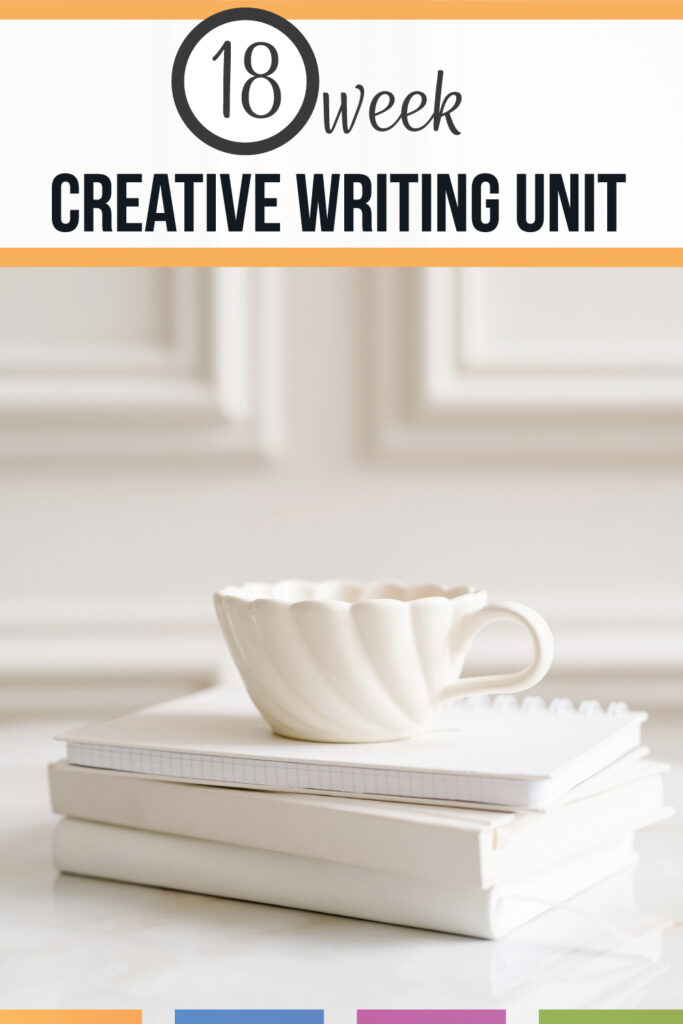
First Week of School for a Creative Writing Unit
The first day of school , we complete activities that build awareness into the classroom environment about “creativity.” Do not shy away from setting a foundation of support and understanding as you engage with young writers. During my first creative writing classes, I neglected to spend time establishing expectations and community. The following semester, the time invested early paid off with engaged students later.
Those first days, we also discuss:
- Published vs. private writing. I tell writers they may share whatever they like with me and the class. As a community of writers, we will share with each other. Most of our writing will be public, but some will be private.
- A community of writers. Writing and sharing ideas requires maturity and acceptance. Not everyone will agree is largely my motto (about negotiables, not human rights), and I stress with students that they may read and provide feedback with topics in which they do not agree.
- Routines. Writers write. That sentence might sound silly, but some people believe that humans are born with a skill to write or they are not. Writing well takes practice. The practice can be short and unconnected to a larger product. I typically begin each week with a quick writing prompt , and we share our responses, which of course, builds that community of writers.
Whatever you are teaching—a creative writing unit or a creative writing class—spend some time establishing your expectations and goals with your students. Laying a foundation is never a waste of time! In fact, I believe so much in the power of the first week of a creative writing class that I have a blog post devoted to the concept.
Time: 2-3 days
First weeks: creative nonfiction
Creative nonfiction seems to be the genre of our time. Memoirs, essays, and hermit-crab essays flood bookstores and journals.
When students read captions on social media, profiles of their favorite artists, or long Threads, they are reading creative nonfiction. Not only should students be able to dissect this form of writing, but they should also be able to write in our society’s preferred genre.
Below, I’ve outlined creative nonfiction activities that work with teenagers.

Nonfiction Narrative Writing
Writing narratives (and meeting those standards) are trickier with older students. As a teacher, I struggle: Students will often tell me deep, meaningful, and personal parts of their lives, and I am supposed to grade those writings!
When students write a narrative , I address this situation immediately. Share with writers that their narrative ideas are strong (I believe that to be the truth!), and that in no way are we grading their ideas. Rather, we want their excellent narratives to be communicated in the best light; therefore, we will provide guidance about the structures of narrative writing.
The topic for a nonfiction narrative varies. Often, students write about themselves as learners or as community members. Framing students in a positive way allows them to explore their strengths in life and to build confidence as writers.
Time: 7-9 days

Object Essay
An object essay might sound like a “blah” type of assignment, but the simplicity allows students to push past their normal experiences. An object essay is simple, so they can experiment with their writing.
What object? I have assigned this essay several ways. For instance, I have brought in a very plain object (like a rock) and had students explain it. I like this approach because students can work together to discover the best descriptions.
Another way, my preferred way, is to allow students to choose the object. Students write about a coffee cup, water bottle, car keys, or bus pass. When students choose, the essays are richer with meaning.
Neither approach disappoints me, though! With a plain object, students must stretch themselves to be creative. Judge what your class needs and get students writing!
Time: 3-4 days

How-to Paper
No, not a “how to make a peanut butter and jelly sandwich” paper. A fun and meaningful how-to paper can encourage classes as they see themselves as experts.
What I like about a how-to paper is students get to be the expert in their paper. Finding a used vehicle to buy? Shopping for a formal event? Saving money? Cleaning a closet? Selling at consignment stores? Each writer has an area in which they shine, and a how-to paper allows them to share their knowledge with others. They write about “behind the scenes” or little known secrets.
Of all the creative writing activities, I assign the how-to paper early. It builds confidence in young writers.
Time: 5 days

Sell this Apple
Why an apple? When I wanted students to creatively sell something, I searched for something they could all have in common but sell in different ways. I wanted classes to have one object but to witness the multiple approaches for advertising. Apples (which I could also afford to bring to class) fit nicely.
What do students sell when they “sell an apple”?
- Dips for apples.
- Apples for preschool snacks.
- Charcuterie apple boards.
- Apple crisp.
- Red and green apple rainbows.
Basically, students can create a marketing plan for multiple age groups and other demographics. For instance, they can write a blog post about safety in cutting pieces for young children (and complete some research in the process). They can then “promote” a local apple orchard or fruit stand.
Another advertisement is an apple pie recipe for a Thanksgiving brochure for a supermarket.
When I gave students something simple, like an apple, they ran with the idea. Then, we can share our ideas for selling apples.

A profile is difficult to write, so this assignment is normally my last assignment of the quarter. Before we switch to writing fiction, we apply all our concepts learned to writing a profile.
Profiles are more than summaries of the person. Writers must take an angle and articulate the person’s traits utilizing Showing vs. Telling. Of all creative writing assignments, the profile, might be the most difficult. I place it in the middle of the semester so that writers understand our goals in class but are not tired from the end of the semester.
Time: 10-12 days
Final weeks: fiction
Fantasy, historical fiction, mystery, romance: Students consume a variety of fiction via books, movies, and shows. Fictional creative writing activities invite young writers into worlds they already consume.
Below, I’ve outlined some that work with teenagers.

Alternative Point-of-View
Grab some googly eyes or some construction paper and send students loose. (A few guidelines help. Should students remove the googly eyes from the principal’s office door?) Have them adhere the eyes to an inanimate object to make a “being” who learns a lesson. They should snap a picture and write a quick story about the learned lesson.
What type of lesson? Perhaps an apple with a bruise learns that it still has value and is loved with blemishes. Maybe a fire extinguisher realizes that its purpose is important even if it isn’t fancy.
Honestly, the creativity with the googly eyes adhered to inanimate objects is so simple, but it always is my favorite event of the semester. I officially call it the “ alternative point-of-view ” activity, but “googly eyes” is how my writers remember it.
Time: 2 days

Create a Superhero with a Template
A superhero does not need to wear a cape or fancy shoes. Rather, in this creative writing activity, students build a superhero from a normal individual. When I created the activity, I envisioned students writing about a librarian or volunteer, but students often write about a grandparent (adorable).
Since students enjoy graphic novels, I wanted students to experience making a graphic novel. The colorful sheets allow students to add their ideas and words to pages that fit their messages.
After students create a comic book, they will also write a brief marketing campaign for a target audience. Learning about who would buy their graphic novel typically leads them to parents and librarians which should lead students to discover the importance of reading. The advertising campaign additionally serves as a reflective component for the initial activity.

Product Review
Product reviews and question/answer sections are a genre all their own. SO! Have students write reviews and questions/answers for goofy products . Students will find a product and write several reviews and questions/answers.
This quick activity lends itself to extension activities. Once, a teacher emailed me and said her school bought some of the goofy products for a sort of “sharing” day with the school. Since students have access to pictures of the item, you can make a “catalog” for the class out of a Canva presentation and share it with them and your colleagues.
Here are a few examples:
- Banana slicer .
- Horse head .
- Wolf shirt.
Aside from the alternative point-of-view activity, the product reviews remain my personal favorite part of a creative writing unit. Writers find random products and write goofy workups that they share with the class.
Time: 3 days

Character Creation
Creating a well-rounded and interesting character requires prep work. The brainstorming part of the writing process, the pre-writing? We spend lots of time in that area as we create fleshed out characters.
I like to start with a multiple-choice activity. We begin my imagining the main character. Next, students take a “quiz” as the character. How does the character eat? What sort of movies does the character enjoy? hate? After the multiple-choice activity, they can derive what those pieces explain about their characters. Finally, they can begin to brainstorm how those pieces will develop in their story.

Flash Fiction
Flash fiction is a simple, short story. Writers might cheer when they hear I expect a 300-word story, but often, they discover it is a challenging assignment from class. A large part of a creative writing unit is giving students a variety of lengths so they can practice their skills under different circumstances.

Historical Fiction
Historical fiction is a popular genre, and classes are familiar with many popular historical fiction books. I find it helpful to have several books displayed to inspire students. Additionally, I read from the books to demonstrate dialogue, pacing, theme, and more.
Since my historical fiction activity takes at least two weeks to accomplish, we work on that tough standard for narrative writing. To that end, these activities target the hardest components:
- Pacing within a narrative.
- Developing a theme .
- Building imagery .
- Creating external conflicts in a story.
- Establishing a setting .
First, I used pictures to inspire students, to get them brainstorming. Second, I created those activities to solve a problem that all writers (no matter the age!) have: Telling vs. Showing. I found that my writers would add dialogue that was heavy on explanation, too “world building” for their narrative. The story sounded forced, so I took a step back with them and introduced mini-activities for practicing those skills.
Third, the above creative writing activities can EASILY be assignments independently for short and fun assignments. I teach them with historical fiction because that activity is at the end of the semester when my expectations are higher, and because students enjoy writing historical fiction so they are invested.
But! You can easily add them to another narrative activity.
Time: 10-12 days

A clean tabloid! Tabloids are largely replaced by online social sharing creators, so they are fun to review with students. Students might not be familiar with tabloids at the grocery store checkout, but they are familiar with catchy headlines. They will be completely ready to write a tabloid !
To ensure a clean tabloid, I ask students to write about a children’s show, something scandalous happening from a cartoon. The results are hysterical.
Time: 4 days

Children’s Book
I have two introductory activities for the children’s book. One, students answer questions about a mentor text (another children’s book). Two, students evaluate the language of a specific book to start them in their brainstorming.
My students write their children’s book as a final activity in class as it requires all the elements of creative writing. When a school requires me to give a final exam, students write a reflection piece on their children’s books. If you are looking for a finale for your creative writing unit, a children’s book is a satisfying ending as students have a memorable piece.
Time 10-12 weeks
Final note on creative writing activities and bundle
I intended for this post to inspire you and give you ideas for teaching either a creative writing unit or a creative writing class in ELA. My first time through teaching creative writing, I worried that my lessons would flop and that students would not find their groove with me. I found success, but with modifications, I formed a cohesive semester.
The first time through, I did not frontload information and expectations. (Spending time at the start of class is my biggest message! Please establish groundwork with students!) I also did not provide concrete enough guidelines so students understood the differences between the assignments. After a few semesters, I developed my creative writing unit . With a variety of activities and an appropriate amount of structure, I found success, and I hope you do too.
Subscribe to our mailing list to receive updates about new blog posts, freebies, and teaching resources!
Marketing Permissions We will send you emails, but we will never sell your address.
You can change your mind at any time by clicking the unsubscribe link in the footer of any email you receive from us, or by contacting us at [email protected] . We will treat your information with respect. For more information about our privacy practices please visit our website. By clicking below, you agree that we may process your information in accordance with these terms.
We use Mailchimp as our marketing platform. By clicking below to subscribe, you acknowledge that your information will be transferred to Mailchimp for processing. Learn more about Mailchimp’s privacy practices here.
*This post contains affiliate links. You can read my complete disclosures .
creative writing creative writing activities

7 Writing Ideas for the First Week of School
This post contains an affiliate link
The first week of school is usually a blur. We are all settling into a new routine and the summer haze is lifting-slowly. This is the time we are getting to know our students, but also the time there is much to be done. We are settling into a new routine, adjusting students to a new routine, filling out enrollment reports, and putting the finishing touches on our classrooms. For this reason, coming up with first week activities can be a bit stressful. For the past few years, I’ve used these seven writing activities the first week of school at various times throughout the day and they all serve their own purpose.
Goal Setting
My fifth grade team is departmentalized and I teach writing. For this reason, I make this activity specifically writing focused, and put these as the first page of their binders on the first day of school. However, I’ve given an example in the picture below of how this can be done for any subject or grade level. Goal setting is extremely important because it reminds students that there is a purpose and a focus to their learning. I refer back to this page often throughout the year so they see whether or not they are meeting their goals. The picture I listed here is general, but I encourage you to have students list several goals and make them specific and attainable. You can download this FREE goal setting template here .

My Three Best Summer Memories
This activity is great for the very first day. Students can reflect on their summer and then share. It’s a great icebreaker because students love to read aloud their memories and share their pictures. Many times, individual personalities also come through and you can get a sense of what student hobbies are!

What I Want My Teacher to Know About Me
This is my favorite writing activity for the first week of school. I learn so many things about my students, and I constantly look back at these pages throughout the year. I’ve had students share simple things with me such as their favorite ice cream flavor, or very personal things such as family situations at home. This assignment is special to me because students feel they can share and they know I will read them. I often make sure I mention them throughout the next few weeks. For example, “Christopher, when do you start soccer practice?” Or, “Kayla, I’ll make sure I give you a signal before I ask you to read out loud because I know it makes you anxious.” This helps reduce the anxiety for students and create a friendly class atmosphere!

This Year I Want to Learn
I love reading what types of things students are interested in learning for the year. Some of which we won’t be able to cover, but I try my hardest to make sure students learn many at least one of the things they share on this sheet. Even if it means they have to do some of their own research! It’s a great way for students again to have a goal and a focus. Download this template for FREE here.

Grade Level KWL
This is something I created as kind of a unique spin on a KWL. In the morning, you can have students write what they k now and w onder about the grade they are starting. At the end of the day, have students write what they l earned about their classroom/grade. It’s a also a great way to reinforce rules and expectations!

The First Day of School
This writing activity is straight forward and simply allows students to share how they felt when they woke up in the morning. It’s also a perfect follow up activity to the book First Day Jitters by Julie Danneberg . The story has an awesome message about how teachers are nervous on the first day also! I’ve read it every year and it’s perfect for any grade level. I’ve read this story in both first and fifth grade!

All About Me
Although this has been done so many different ways, the All About Me activity is a classic! Letting your students be creative and share some special things about themselves is always a great icebreaker. This activity will never get old!

In addition to the free downloads above, you can purchase my full Back to School Activity set here . Have a wonderful start to your school year!

- back to school
- back to school getting to know you
- back to school writing
- back to school writing ideas
- first day of school
- first week of school
- first week of school writing activities
- first week of school writing ideas
- getting to know you writing ideas
- writing ideas
- writing ideas for the first week of school

Related Articles

- Teaching Setting in Fiction Writing: Creating Creative Places
When it comes to fiction writing, sometimes teaching setting can be the most daunting. When…

- Why You Need to Be Teaching Tiered Vocabulary
Vocabulary instruction is often overlooked, since it is typically embedded in our overall daily…

- How do you know which vocabulary words you should be teaching?
How do you know which vocabulary words you should be teaching? Two questions…
Leave a Reply Cancel reply
Your email address will not be published. Required fields are marked *

Recent Posts
- Making the Most of Your Morning Work : A Vocabulary Focus
- Interesting Nonfiction Topics Kids Love to Learn About
Recent Comments
- LMBLiteracy on Using Color as a Writing Strategy
- Maerea on Using Color as a Writing Strategy
- Carrie Rock on Tips for Teaching in a Departmentalized Classroom
- mysite on Teaching Content Through Poetry
- LMBLiteracy on Tips for Teaching in a Departmentalized Classroom
- January 2024
- December 2021
- February 2021
- December 2020
- October 2020
- February 2020
- January 2020
- December 2019
- November 2019
- October 2019
- September 2019
- August 2019
- February 2019
- January 2019
- November 2018
- October 2018
- Teaching Ideas
- Uncategorized
4th graders at Coloma Intermediate School meet veteran pen pals
COLOMA, Mich. (WNDU) - Ten veterans, some coming as far as Cincinnati, came to Coloma Intermediate School on Wednesday to meet their fourth-grade pen pals, for the first time.
As a part of “Operation S.A.V.E.,” these pals enjoyed lunch and cake together.
This was a celebration of months writing letters back and forth to one another.
“Operation S.A.V.E.” founder and Coloma Intermediate fourth-grade teacher Valerie Krieger said the kids are so eager to correspond, they’ll turn around a letter in a week’s time.
“For these kids, the most exciting part of the day is, ‘Have you checked the mail? Have you checked the mail?’” Krieger said. “And now our custodian knocks on the door and delivers the mail, and the kids just get so excited to find out if it’s theirs.”
Krieger hopes this program grows throughout not only the school, but throughout the nation someday.
She’s seen through Operation S.A.V.E. just how writing letters can turn pen pals into friends.
Copyright 2024 WNDU. All rights reserved.

Attempted abduction of 2 students walking home in Mishawaka

Truck driver killed in fiery Nappanee crash identified

First Alert Forecast: Rain with Scattered Downpours Expected Saturday

Time is running out to get up to $500 from Walmart as part of a class action settlement

Man walks away after train hits car in Mishawaka
Latest news.

Rudy Yakym shares thoughts on Donald Trump’s conviction

Medical Moment: Induction therapy for tongue cancer

Congressman Rudy Yakym responds to Trump's conviction

IMAGES
VIDEO
COMMENTS
Here you'll see 15 fabulous first day of school writing activities — This list of ideas is packed full of fun and engaging ways to interact with the new group of kids in your classroom. Plus, you'll find nine first day of school writing ideas, twelve new school year resolutions, 8 ice breakers, and 5 school success tips. Oh yeah….
3. Write three goals you want to achieve this school year plus how you plan to reach them. 4. Draft a first day of school story that is rather unusual. 5. Tell about your typical morning routine. 6. Describe the steps you plan to take to achieve your academic goals and how you'll stay motivated. 7.
Contents. Here are 35 best first day of school writing prompts: Conclusion: Similarly, back to school writing prompts not only help in capturing the essence of this pivotal moment but also spark creativity and imagination in students. Dive into our curated list of 35 prompts that will whisk you away on adventures, invoke introspection, and ...
Here are some fun ice-breaker writing activities to get the new school year off to a strong start writing-wise. The A to Z of Me! Poem. Students write an acrostic poem about themselves in the A to Z of Me. The poem's first line starts with the letter A, and each new line begins with the following letter of the alphabet, which should reveal ...
First Day of School Writing Prompts: Middle School Students. Grades 7-8. Classroom Prompt Assignments. Stream of consciousness is when a character lets their thoughts continuously flow. Write a stream of consciousness story of your own and see where your thoughts take you. For the new school year, what new skill would you choose to learn if ...
Pop Culture Quiz. Take a break from the first-day-of-school stress with a pop quiz — a pop culture quiz. In advance, create a list of 10-15 questions about current pop culture, from music to movies. Then, to begin the game, divide the class into multiple teams. Distribute paper and pens/markers or personal whiteboards to each team.
10. Write about two habits you need to change plus what you will do in order to improve. 11. Describe the perfect school day. 12. The topic is the first week of school. Now generate a list of actions and things related to the topic for every letter of the alphabet. 13. Explain the best ways to study for a test.
Use active voice: Active voice makes your writing more engaging and direct. Instead of saying "the ball was thrown by John," say "John threw the ball.". Use strong verbs and adjectives: Using strong verbs and adjectives can help make your writing more vivid and engaging. Instead of saying "the car was fast," say "the car zoomed ...
For this activity, have students identify a few core memories of their experience with reading. This can be particular moments, books, etc. They choose the memories and then create a timeline with images to share with the class. This can be done digitally using Google Slides or on paper with some coloring supplies.
Write a story about a misunderstanding. Write a story about a strange family tradition, with at least two characters from the family narrating in the course of the story. Write a story about someone who would be described, above all else, as: kind. Write a story that centers on an Instagram post. Write a story that spans a month during which ...
4 Engaging Writing Tasks for High School Students. Short, authentic writing tasks can encourage high school students to compose richer long pieces. By Shawna Kay Williams-Pinnock. July 30, 2021. Cultura Creative / Alamy Stock Photo. It's quite likely that many of your students dislike writing. After all, they're often expected to compose ...
Assigning a personal narrative at the beginning of the school year doesn't have to mean assigning a full, five-paragraph essay. These personal narratives can be anywhere between a sentence long to several paragraphs. Here are some of my go-to back-to-school writing prompts for secondary students.
Spend Only 10-15 Minutes On Your Syllabus. For this reason I suggest that teachers should not spend that first class period going over every painful detail of your syllabus. Spend 10-15 minutes on your syllabus. Hit the high points. Remember, they're going to listen to five or six other lectures detailing syllabi that day.
First writing assignments, assigned. Classes will write a paragraph, a paper, a reflection of some sort. Diving into teaching writing can be a slow process, or with older students, it can begin those first days of class. Here is what I know from teaching over a dozen years: Those first writing assignments with a new class, matter.
This first-day-of-school-writing-activity for high school students is an outstanding way to start the school year. The resource includes two options: an autobiographical writing prompt and a hands-on creative writing prompt. ... This engaging informal writing assignment gives you a chance to see your students' strengths and weaknesses with ...
Below are three downloads that will be great additions to your teaching tool kit. 33 Journal Writing Topics. Write to a Prompt Activity. 10 Vocab Writing Prompts. Use simple back-to-school writing prompts to assess writing skills and learn important information about students! Download back-to-school writing prompts.
This back to school writing assignment for high school English classes will help build classroom community as students create beautiful personal mandalas with descriptive anecdotal writing. With three days of detailed lesson plans, students learn about classical Indian mandalas, develop symbols representative of themselves, write explanatory ...
Students write about a coffee cup, water bottle, car keys, or bus pass. When students choose, the essays are richer with meaning. Neither approach disappoints me, though! With a plain object, students must stretch themselves to be creative. Judge what your class needs and get students writing! Time: 3-4 days.
The First Day of School. This writing activity is straight forward and simply allows students to share how they felt when they woke up in the morning. It's also a perfect follow up activity to the book First Day Jitters by Julie Danneberg . The story has an awesome message about how teachers are nervous on the first day also!
Krieger hopes this program grows throughout not only the school, but throughout the nation someday. She's seen through Operation S.A.V.E just how writing letters can turn pen pals into friends ...
Preparatory for Early College Graduation 2024 at Joe R. Sanchez Stadium